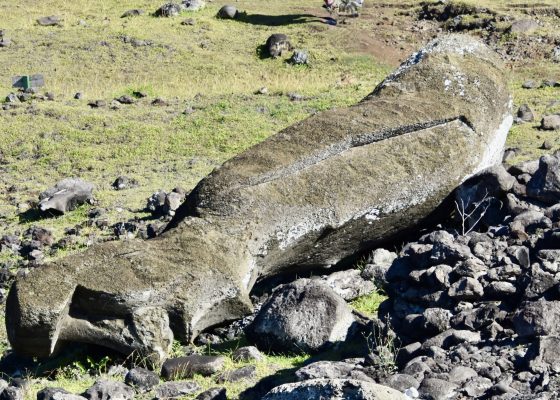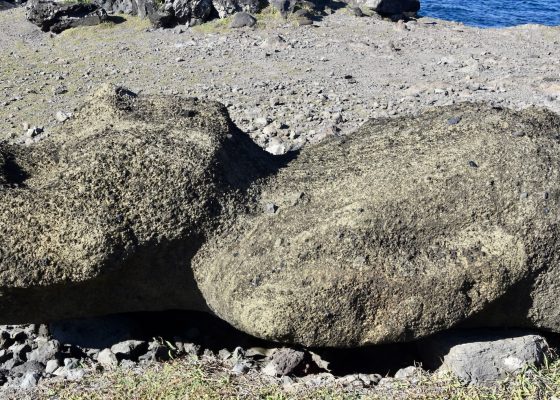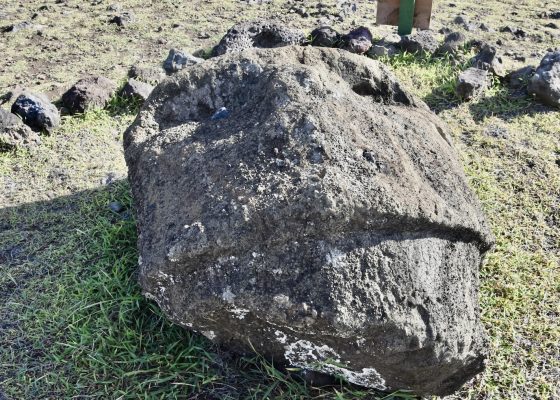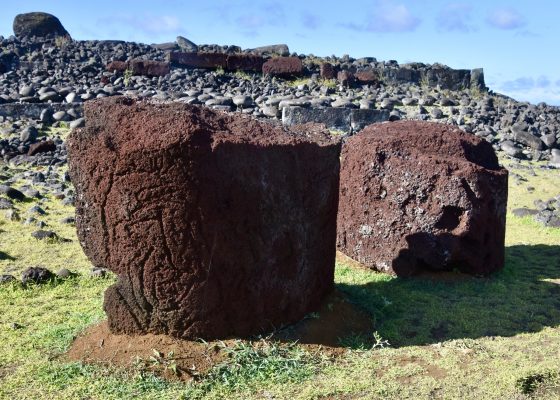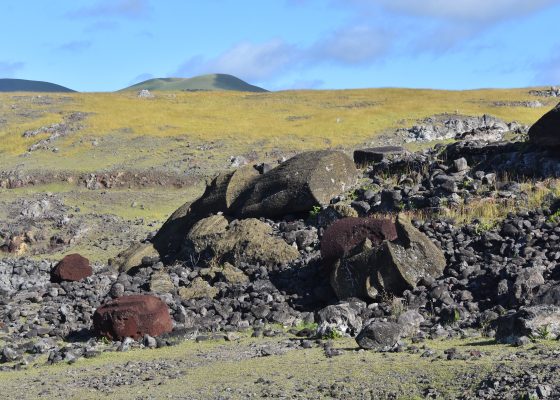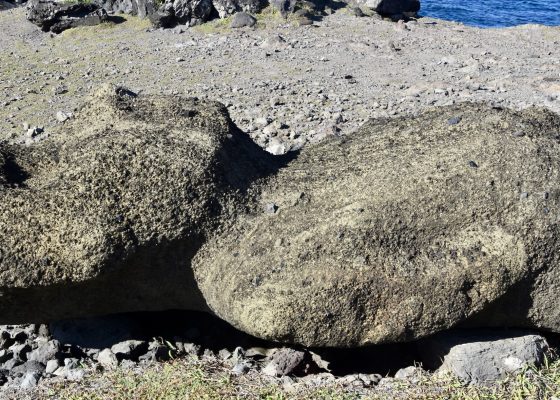Moais of Rapa Nui
In the last post from this unparalleled trip to Chile with Adventures Abroad our group reached our final destination, Rapa Nui, aka Easter Island. In that post I wrote about everything on the island except the main reason we were there, to see the giant statues known as moais that are unique to Rapa Nui. In this post we’ll see and discuss more moais than you probably ever want to see, but trust me, these figures are so entrancing that you will not get tired of visiting them. In short, is it worth the time and expense to come to the remotest place on earth to see them – damn right it is and here’s why.
The Who and Why of the Moais
In the last post I gave a brief history of the settlement of Rapa Nui and noted the wide discrepancy in possible dates of first arrival, all the way from 300 to 1200, although the majority of scholars would narrow the dates to a two hundred year period between 600 and 800 A.D. The two things that there is consensus on are that creation of the first moais did not happen until hundreds of years after the island was settled and that the figures represent real ancestors and not gods. The purpose of building the moais was partly to honour those revered former hereditary chieftains or ariki and to use them as protection from evil. In some cases, the deceased chieftains were buried underneath the ceremonial platforms or ahus on which they were erected.
Now here’s the thing – moais are by no means unique to Rapa Nui. I first encountered them in Tahiti at a site called Marae Arahurahu which I described in this post. Here is a photo of me next to one of the largest of the Tahitian moais. As you can see it is not only much smaller than the moais of Rapa Nui, but also quite different in style.
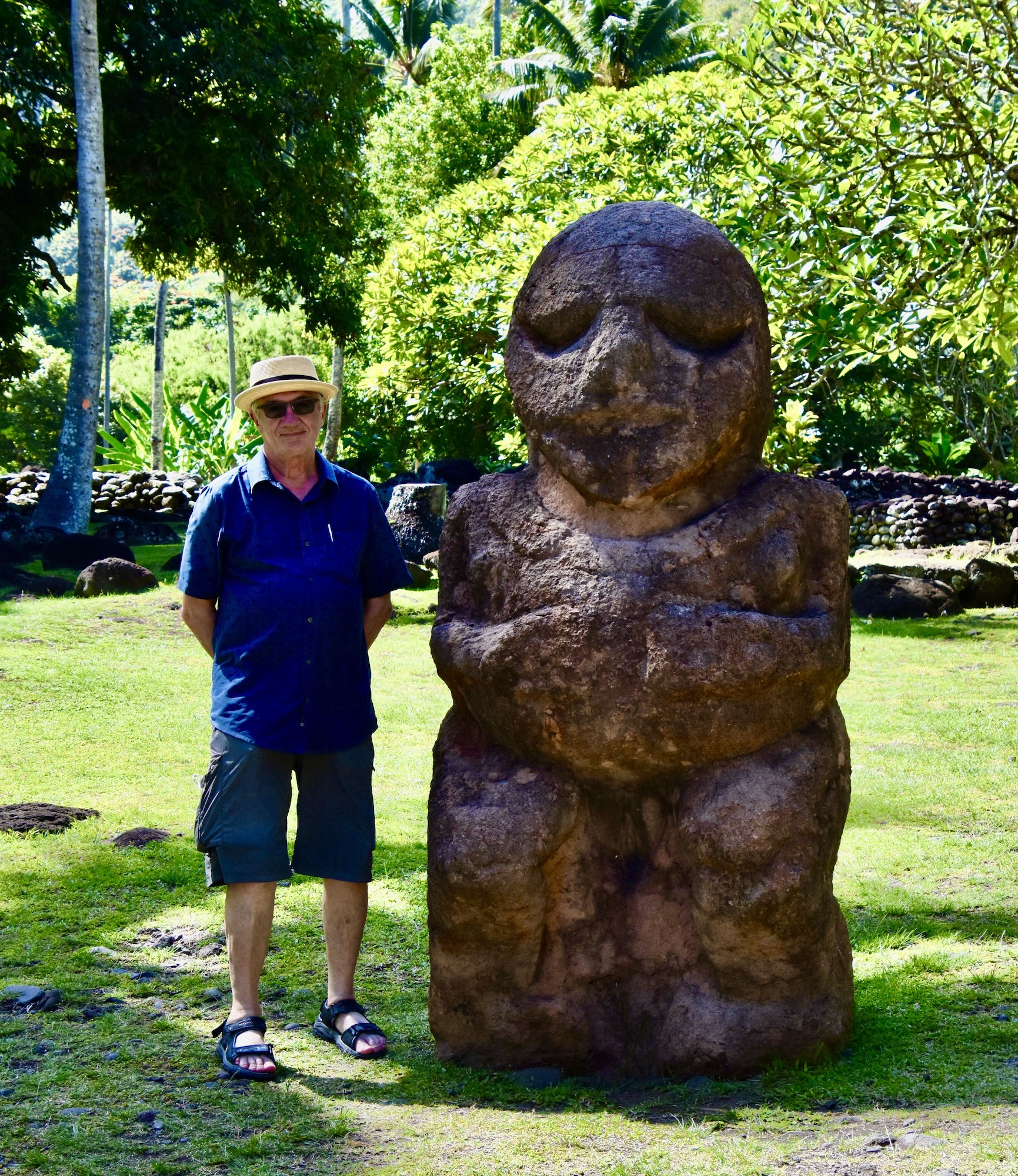
The mystery then is the how and why of the moais of Rapa Nui being so large and so different from those found in other parts of Polynesia. Although it appears the moais did become larger over time, from an average of about 13 feet to one massive unfinished one that would have been 33 feet, the fact remains that they started out as giants and no one really knows why. Of the known 887 moais almost all are made of volcanic tuff, a soft rock that could be carved using much harder tools or toki. However, there are a few made of basalt which is much harder to carve including two in the British Museum that Rapa Nui wants back.
Here is a map of the many locations where the moais are found on Rapa Nui. Over the next two days we will be visiting Orongo, Tahai, Ahu Akivi, Akahana, Playa Anakena, Puna Pau, Rano Raraku, Tongariki, Vai Hu and Vinapu. That should satisfy even the most ardent moai enthusiast.
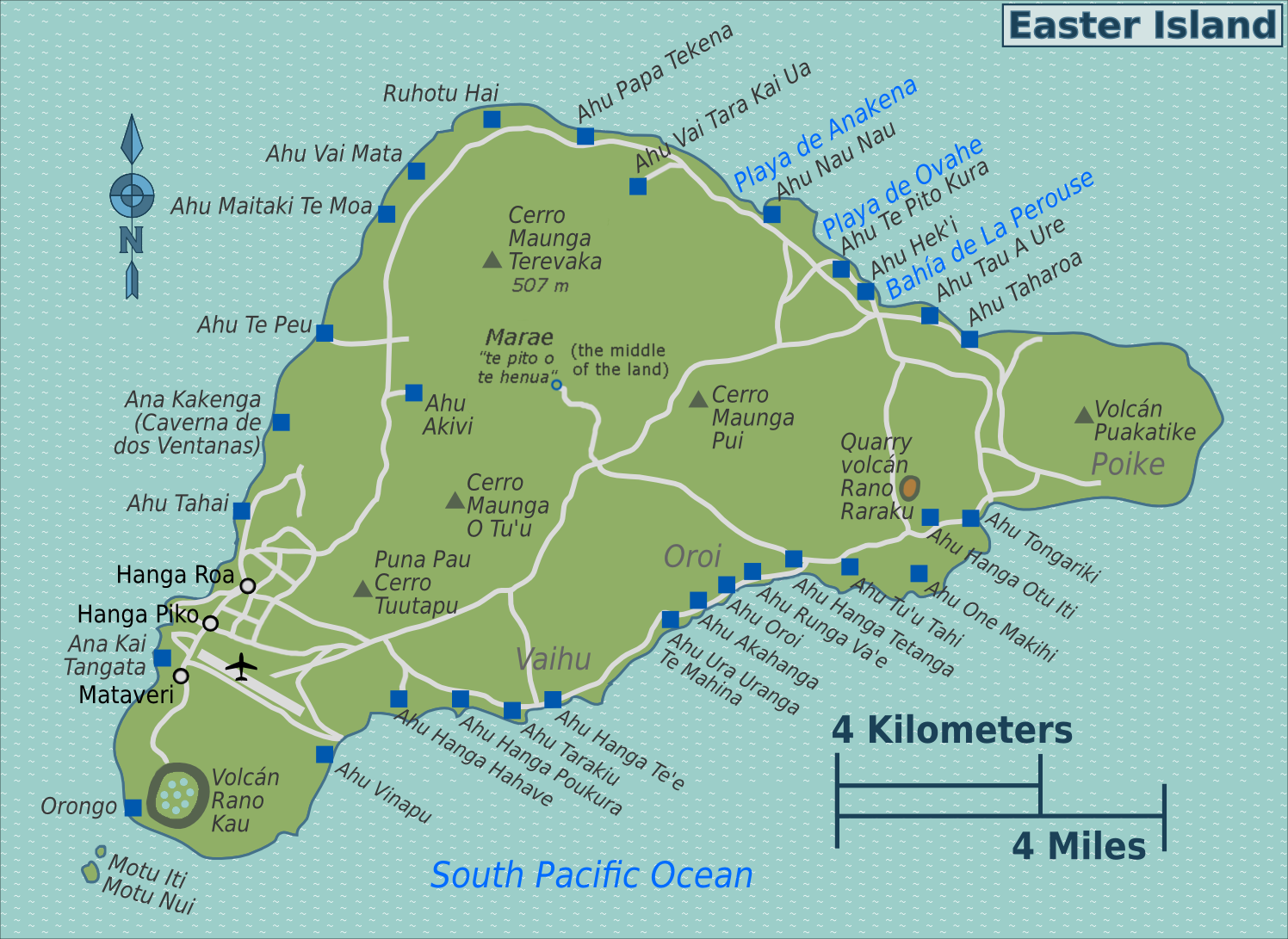
Our guide will be Rapa Nui native Alejandro who knows every moai on the island by name.
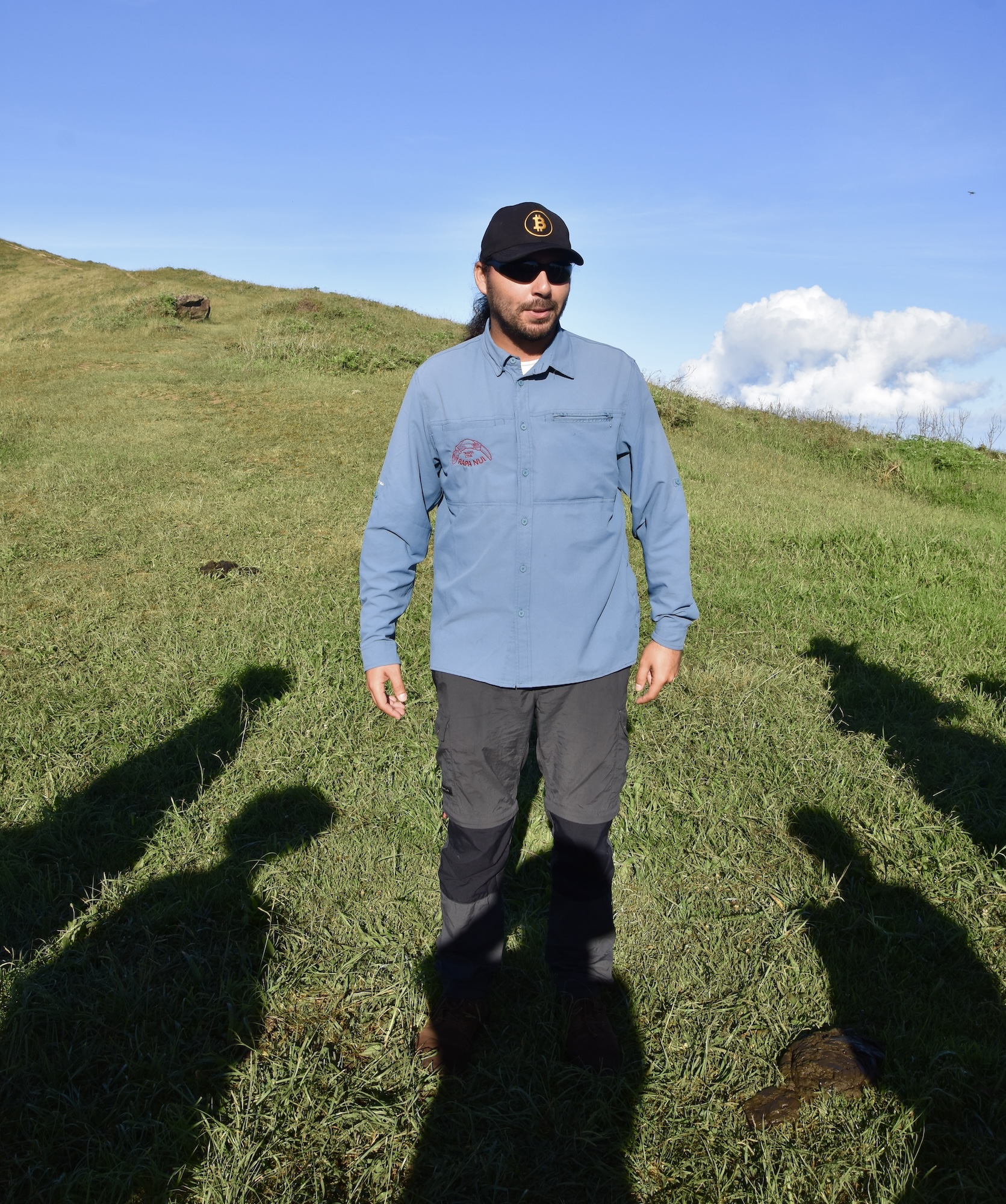
Our first stop will be at Orongo which you will find at the southwest tip of Rapa Nui.
Orongo
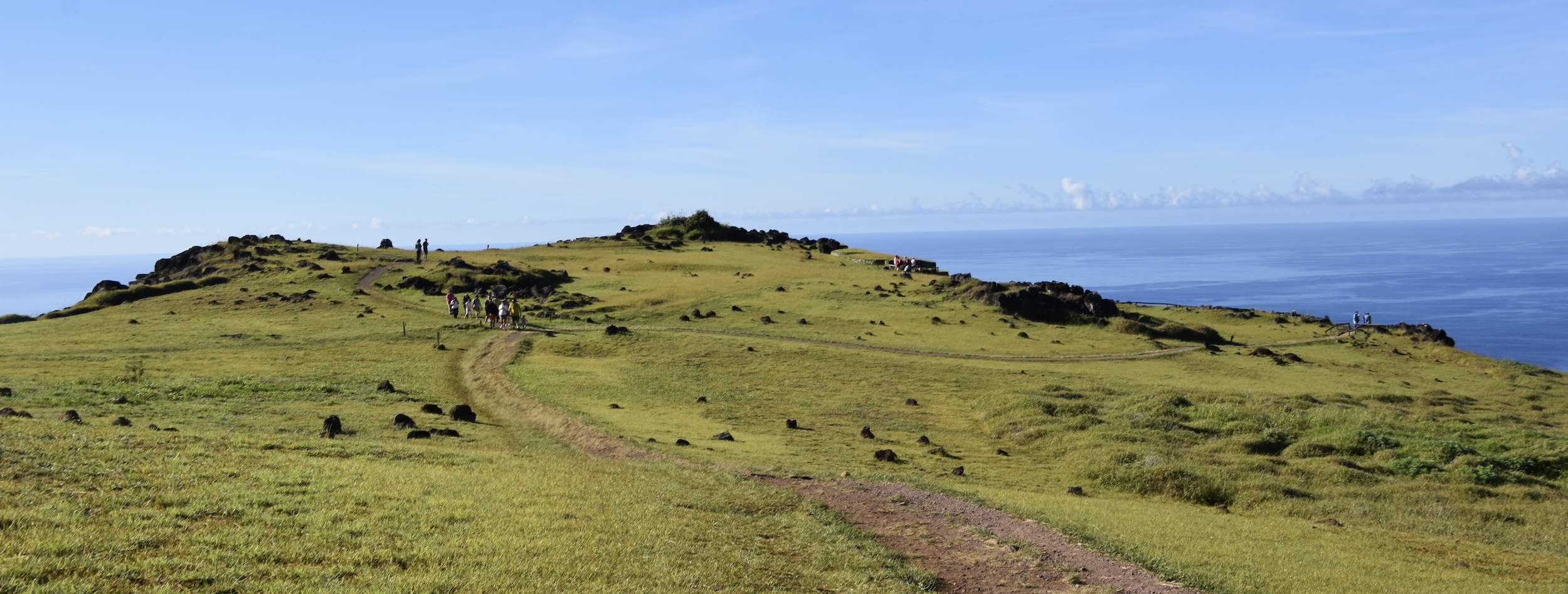
After promising moais galore, on our first stop we won’t see any. Instead we will explore Rapa Nui’s most important archaeological site, the ceremonial village of Orongo. In my first post from Napa Nui I made reference to The Tangata Manu or Birdman cult that sprung up very late in Rapa Nui’s pre-European contact history and continued until abolished by the Catholic missionaries in 1867. It was on this site that the Birdman competition began. This morning it is a very pleasant walk to the archaeological site and the interpretation centre there.
On the way the path follows the rim of the Ranu Kau volcanic caldera with its own version of Crater Lake.
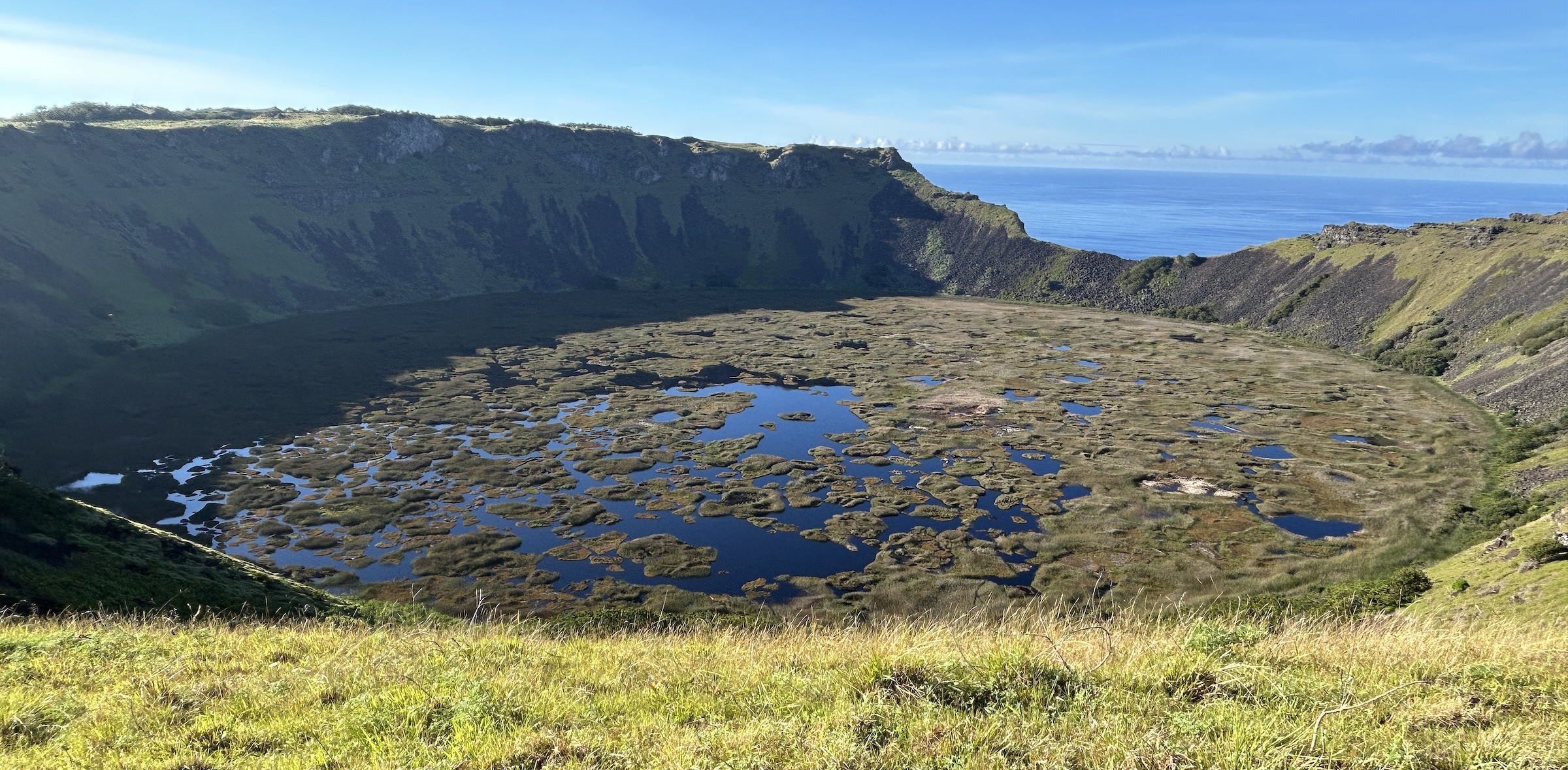
At the Interpretive Centre we learn the story of the Birdman competition which was held annually and involved a race to collect the first egg from the sooty tern colony that nested on Motu Nui every spring and then climb to the pinnacle of Motu Nui and proclaim victory. The clan that provided the winner became the effective rulers of Rapa Nui until the next race. The Birdman cult may or may not have coexisted at the same time as the cult of the moais, most historians think it replaced the latter.
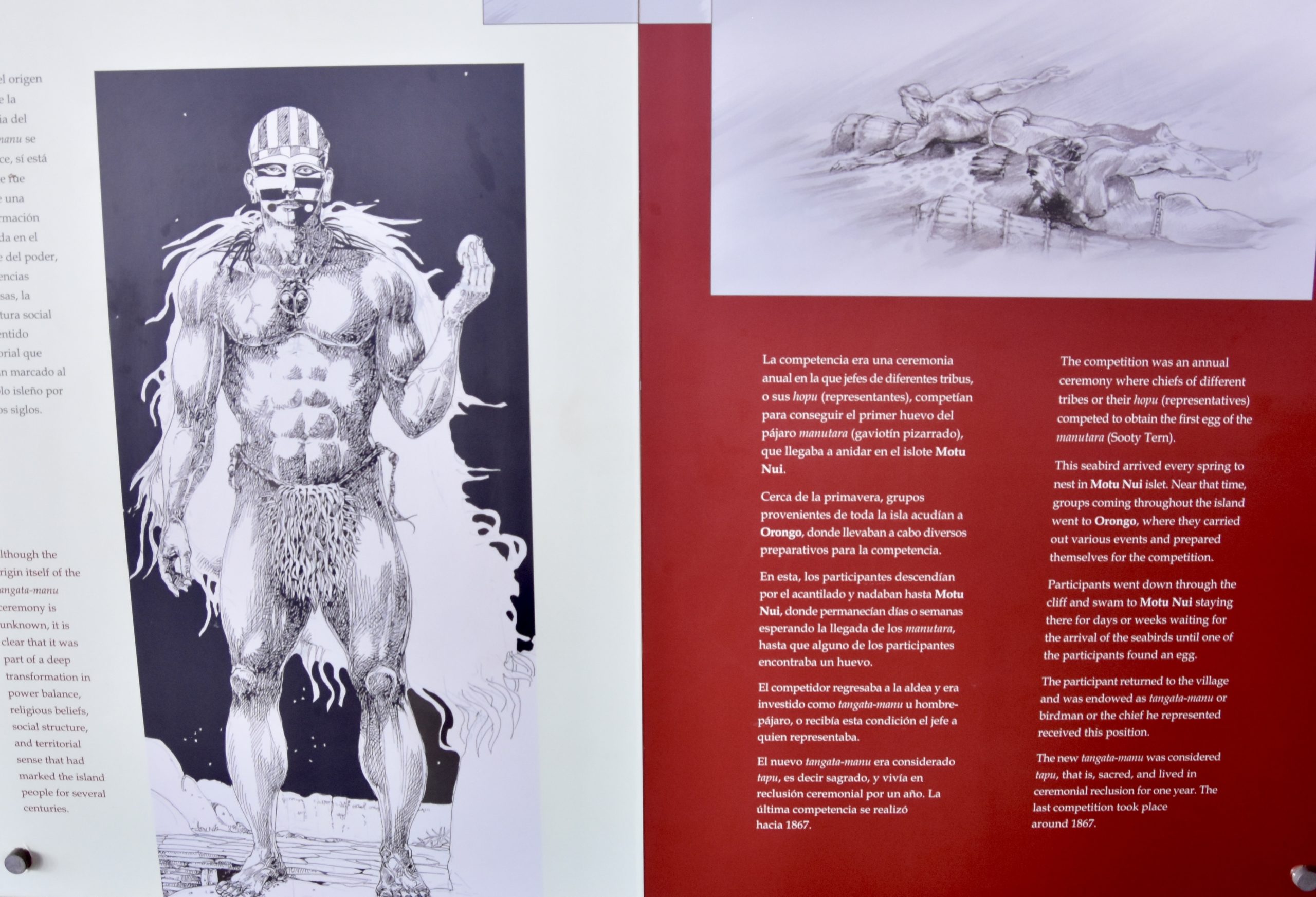
The competition started with the contestants climbing down the gap on the outside rim of Ranu Kau to the ocean over 300 metres (1,000 feet) below.
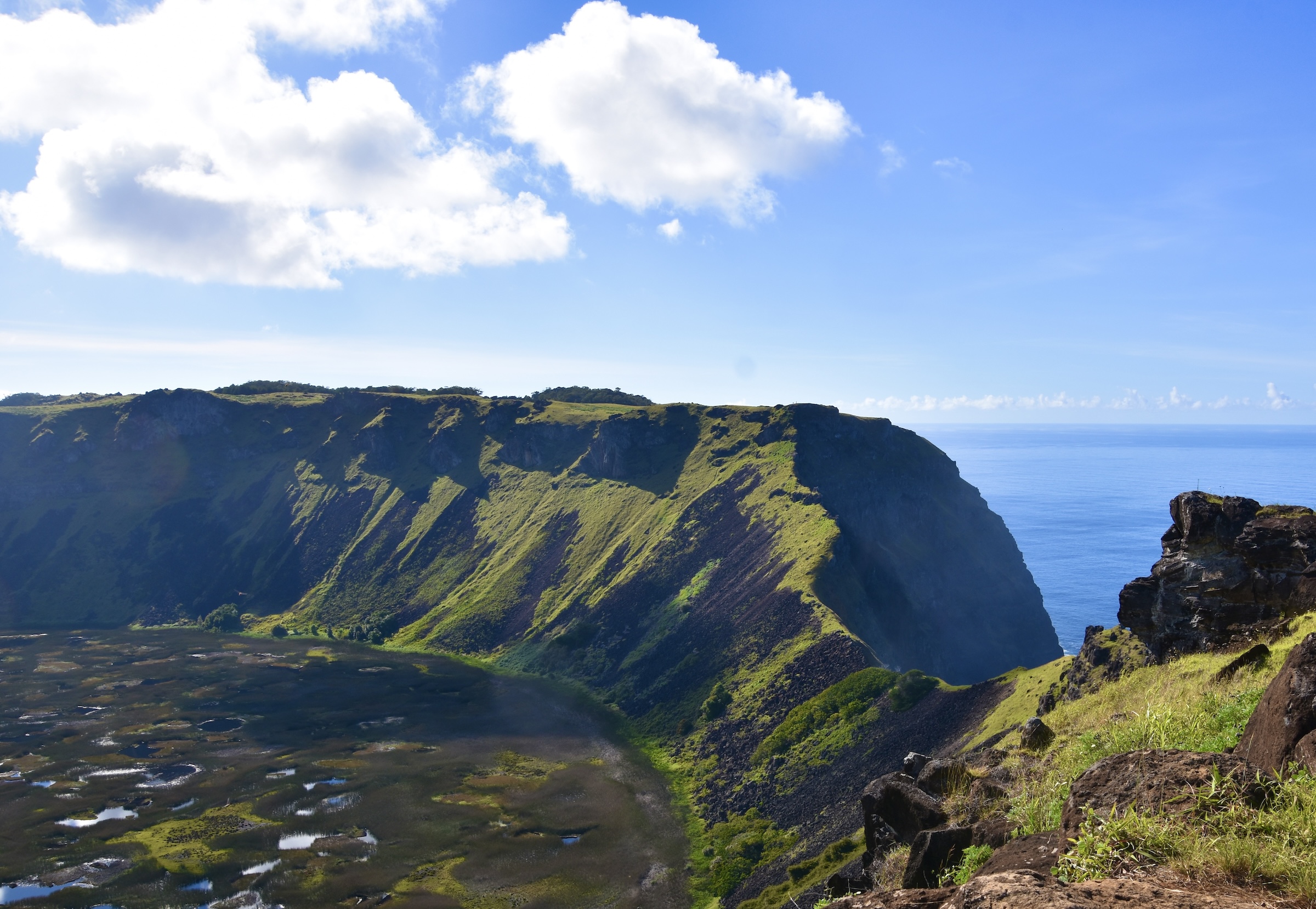
Once there the contestants had to swim through shark infested waters to Motu Nui which is the largest island in this photo. Then climb those cliffs to the tern colony, grab the egg and go to the highest point on the islet to proclaim victory. Not surprisingly, the death toll from falls, shark attacks and drownings was significant
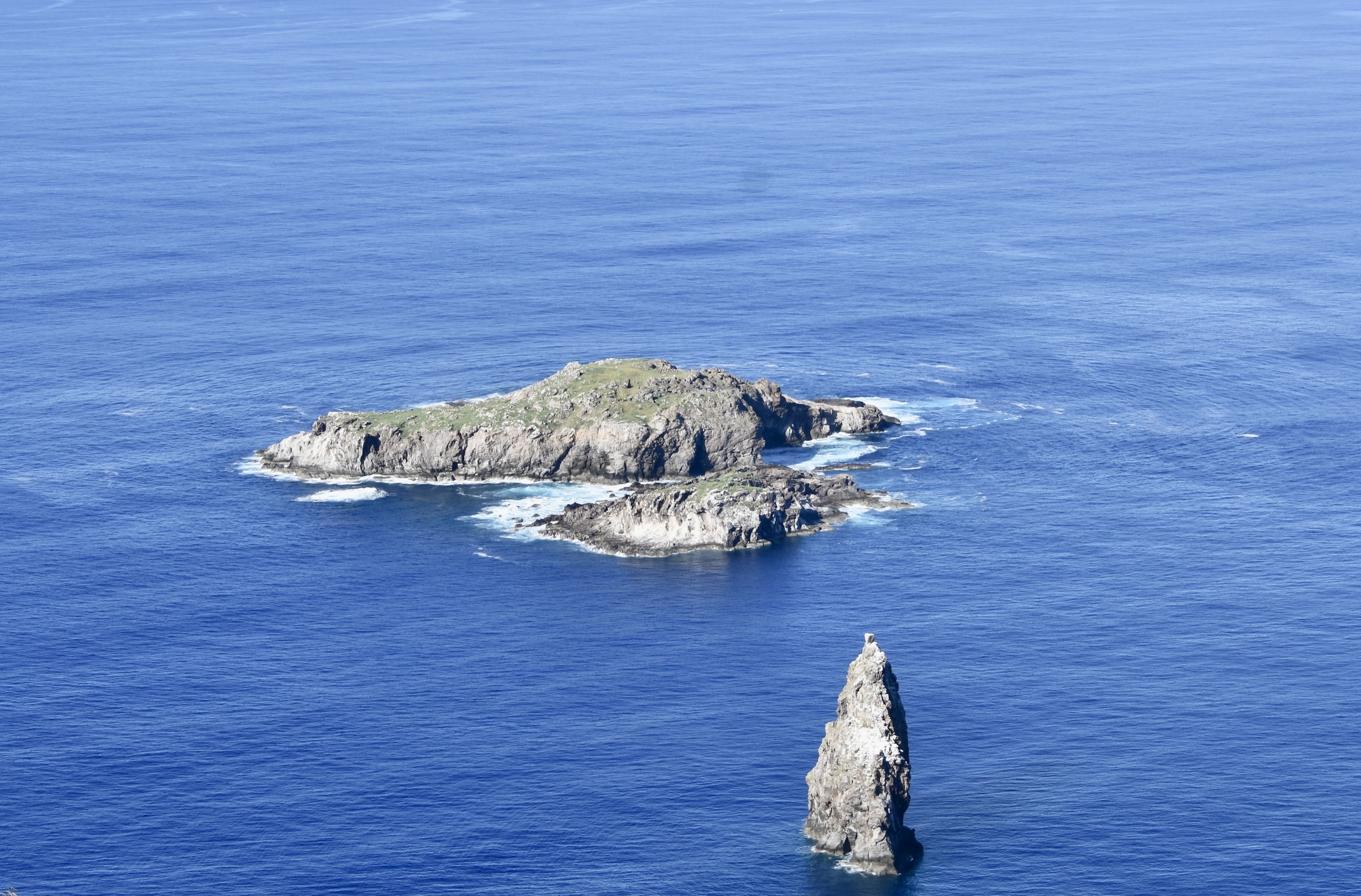
Back at Orongo the various clans would be gathered at the ceremonial houses like this that were made of stone with sod roofs.
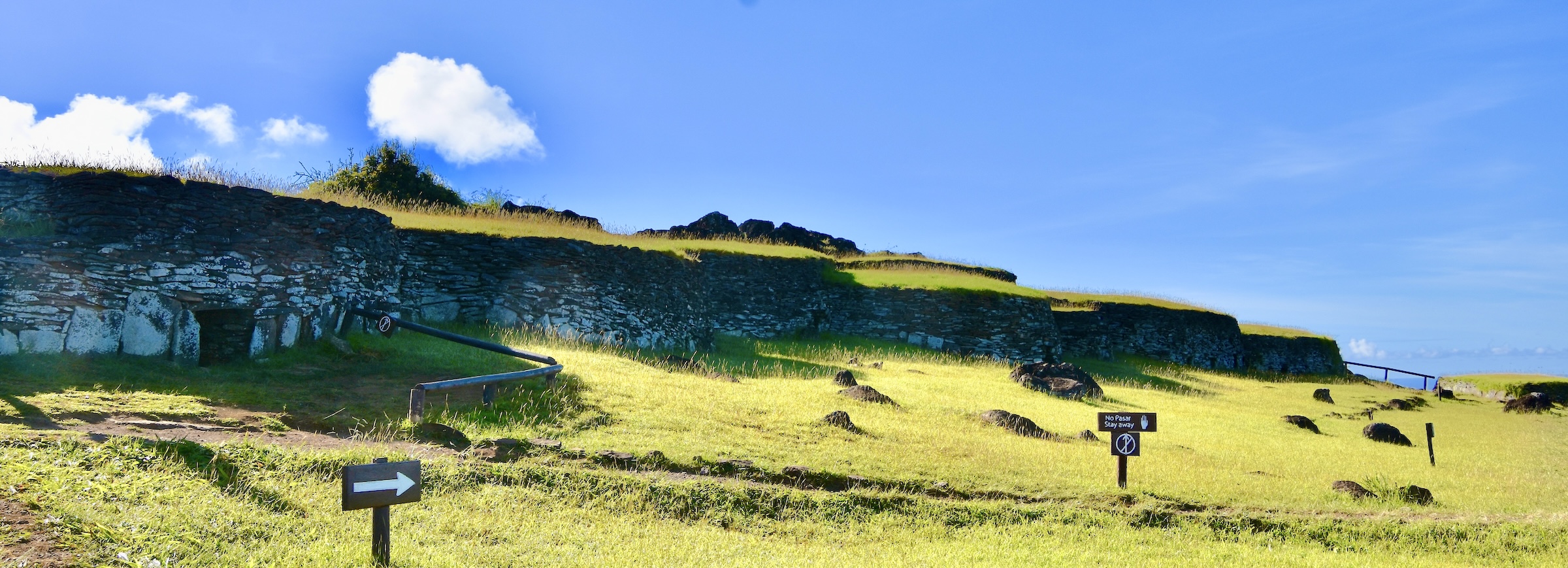
The Orongo site and nearby caves are also notable for their many petroglyphs depicting scenes from the Birdman cult and the principal god of the cult, Makemake. You need an expert like Alejandro to point these out as they are not obvious to the untrained eye. Look closely and you can see the outline of an infant on what was once a water basin.
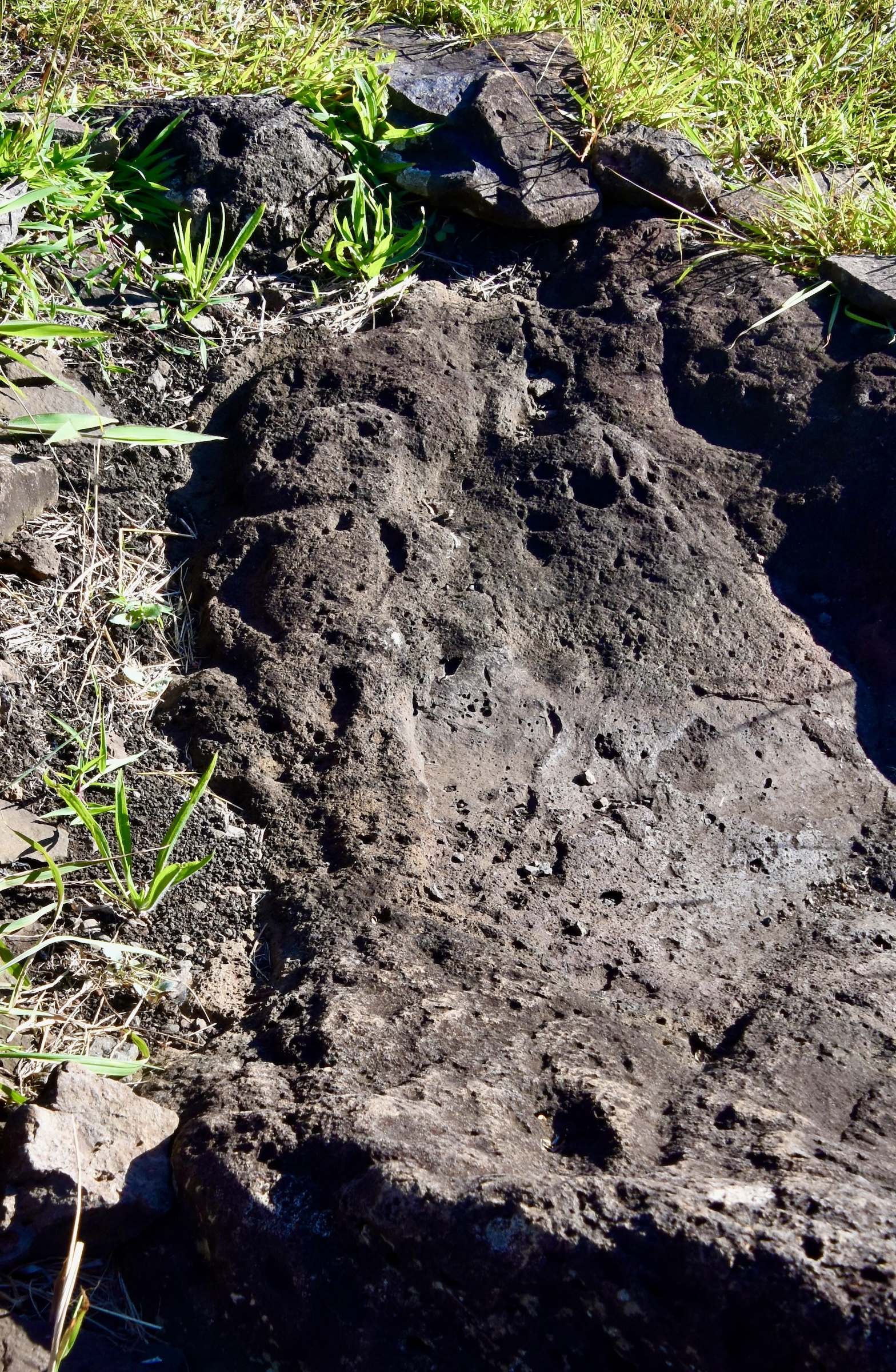
Vinapu
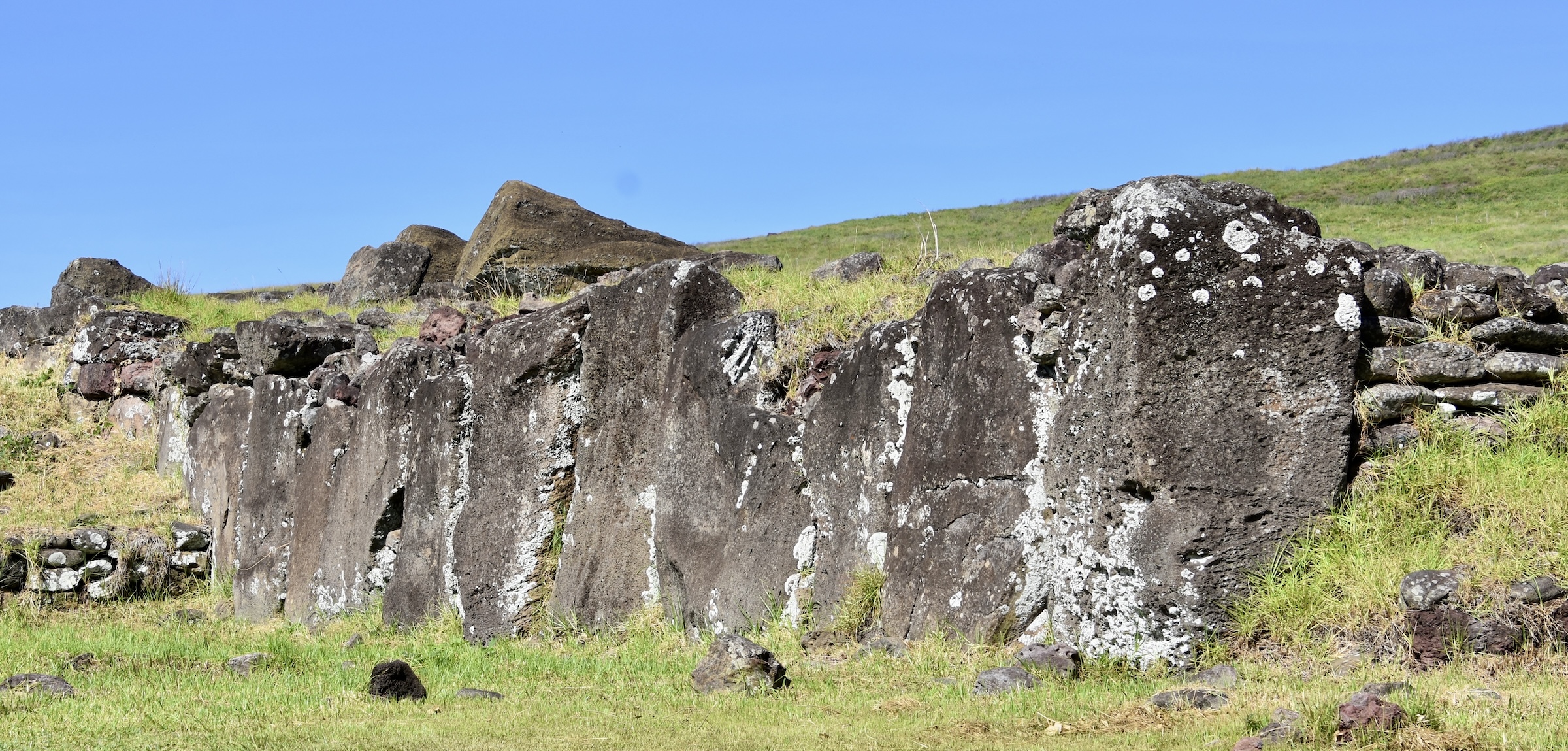
Our next stop is at Ahu Vinapu which is on the south side of Rapa Nui, near the end of the airport runway. It is not particularly know for its moais, but rather the ahus, the structures upon which the moais were placed. This one above is typical of Rapa Nui ahus with rough cut blocks of tuff stacked on each other without the use of mortar.
And then you’ve got this one, Ahu Tahira that is unlike any other not only in Rapa Nui, but anywhere in Polynesia.
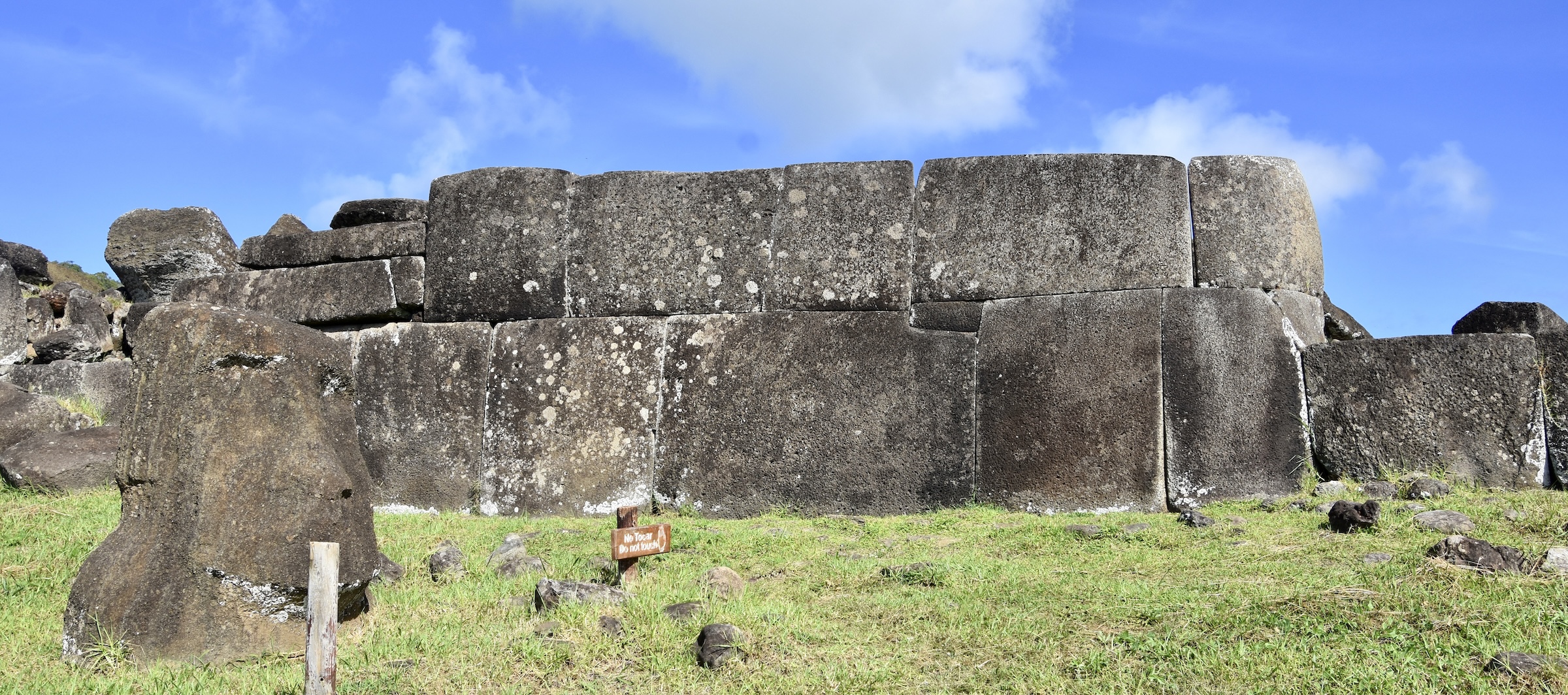
The precise cuts and the way these stones fit so tightly together is very similar to the techniques used by the Incas at Machu Picchu and other sites. Below is a photo of a portion of a wall at Machu Picchu.
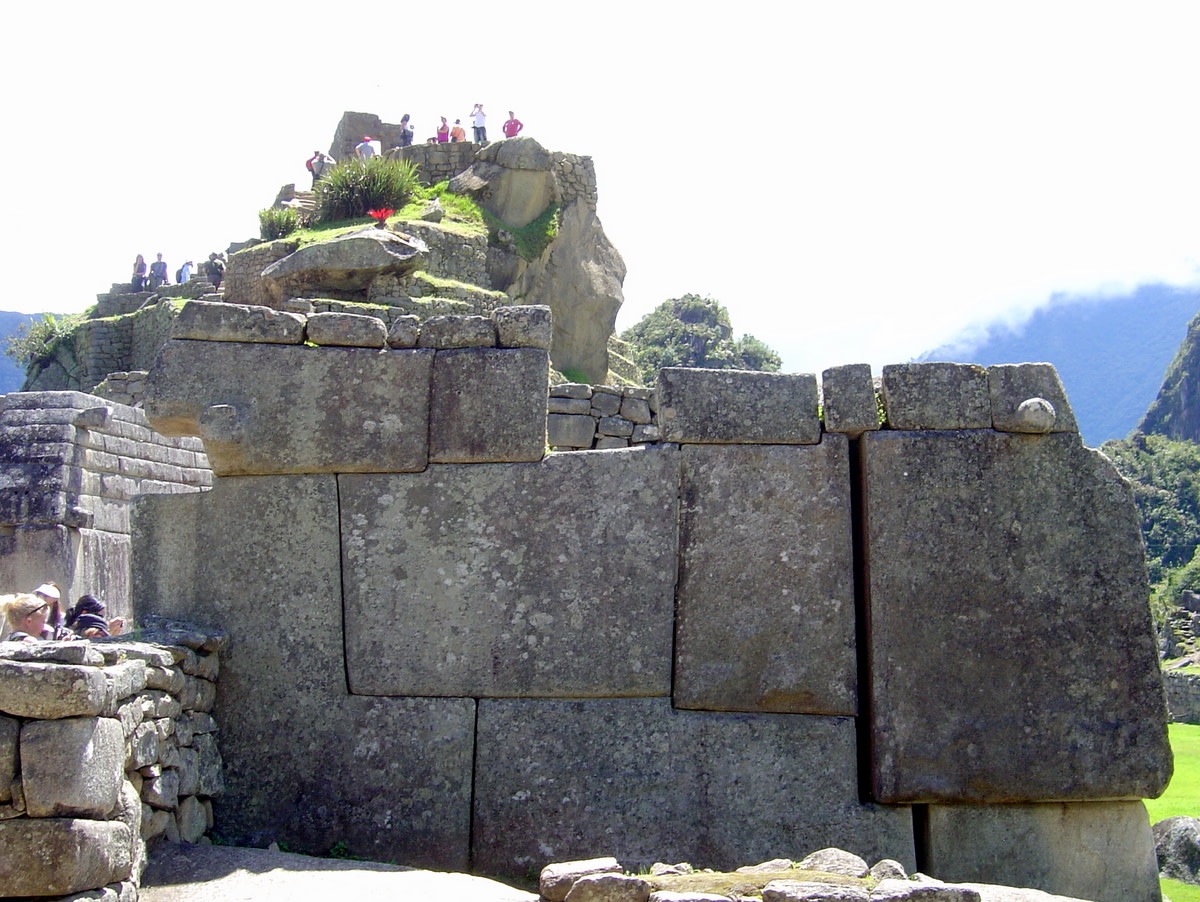
This is one of the reasons that Thor Heyerdahl and a number of historians argue that Rapa Nui, if not settled from South America, did have connections with the Inca Empire. There is an oral legend that Tupac Yupanqui, one of the greatest Incan kings, led an expedition of 20,000 men on a voyage of exploration in 1470 and returned with tales of visiting lands that might have included Rapa Nui. There are genuine questions as to why this one ahu is so much better constructed than any others, but what the answers are will probably never be known.
Vinapu is one site where the moais have largely been left as they were found by the first archaeologists to visit the site which gives the place a greater sense of antiquity than those that have been restored. The moais are not nearly as refined as those we will see later and attest that this is one of the older sites on Rapa Nui, although the ‘Incan wall’ does date from much later.
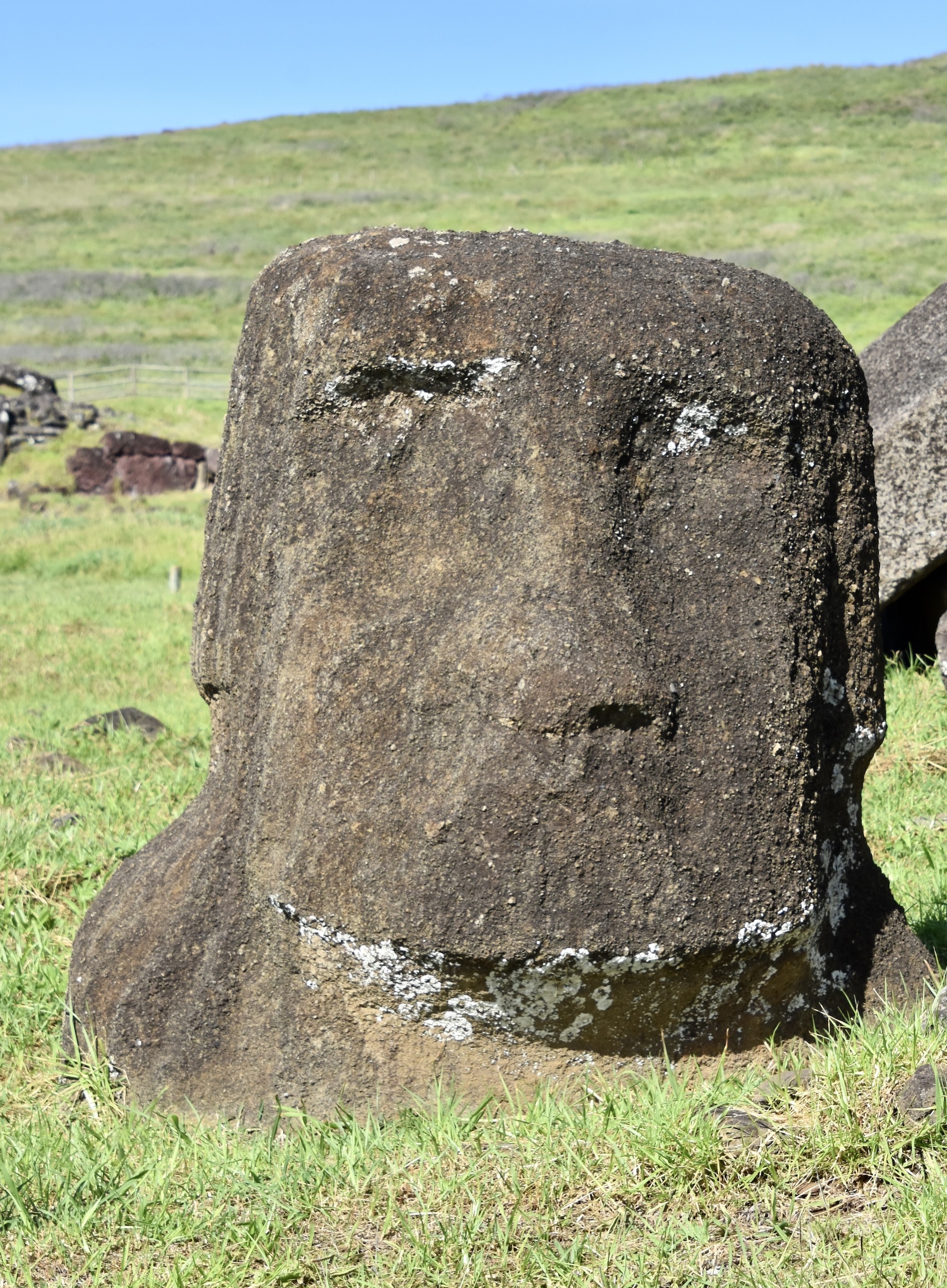
This is also where we see our first pukao, the circular red sandstone figures that once were placed atop the moais and about which there is great debate about whether they were hats or hairstyles. It seems that almost everything on Rapa Nui is capable of controversy and mystery.
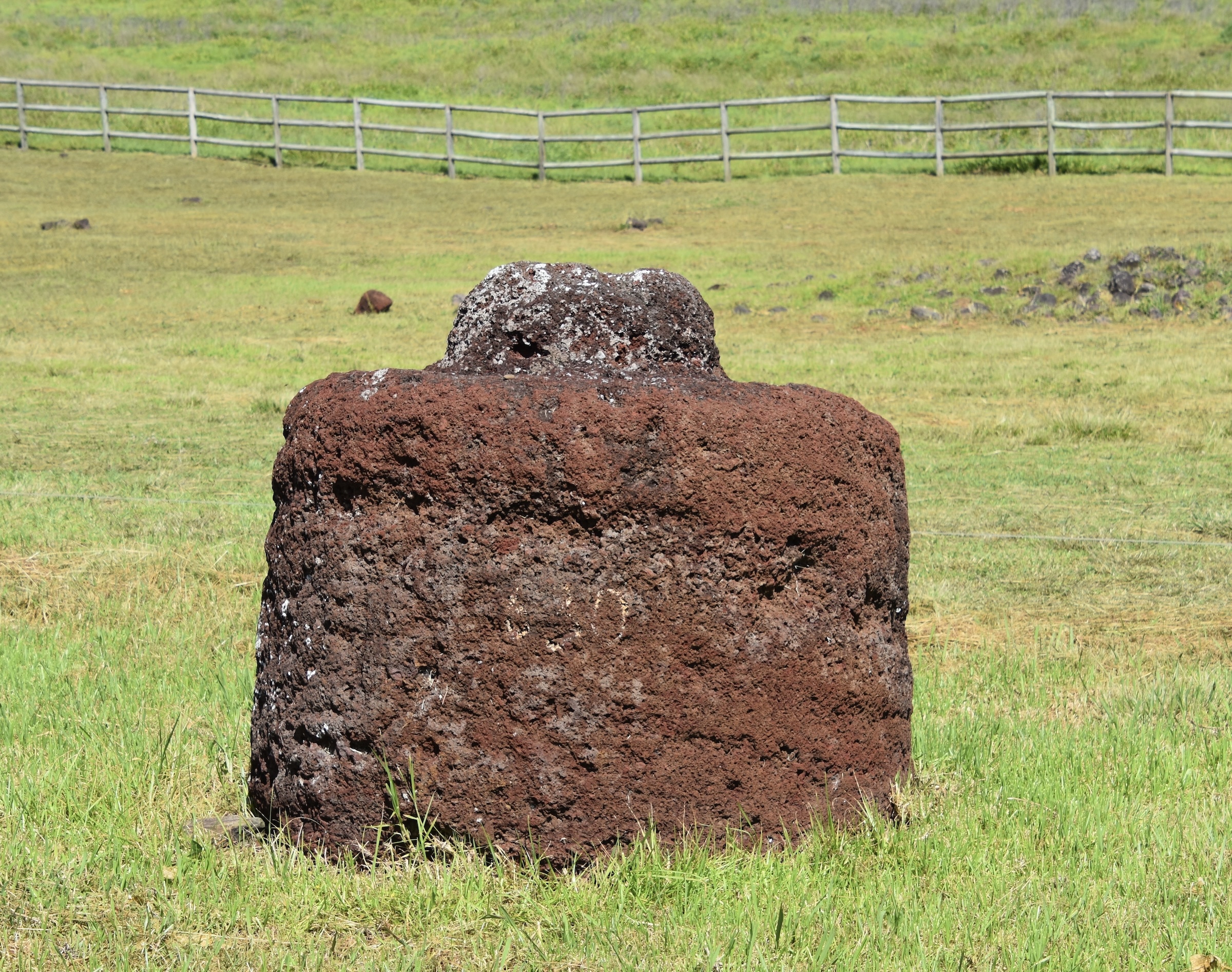
Speaking of mysterious, Vinapu also has one of only two representations of a woman to be found on Rapa Nui. If not for being told, you would not know this was a woman, but I am assured by Alejandro that it is.
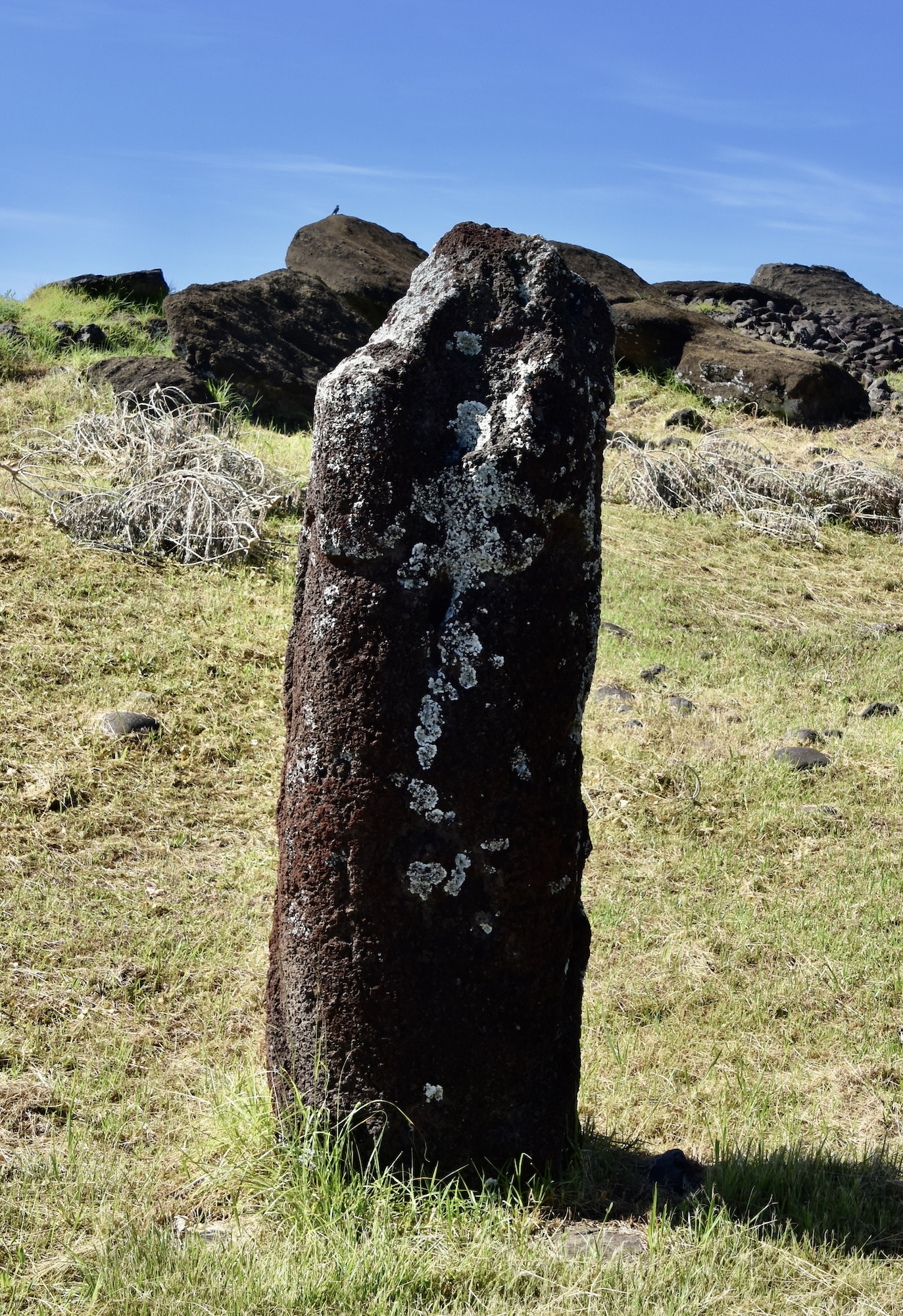
It was raised from its fallen position by American archaeologist William Mulloy who was the one person most responsible for the resurrecting of the moais on Rapa Nui, a project that started in the 1950’s and continues to this day. Here is a photo of the raising of the female moai in 1955.
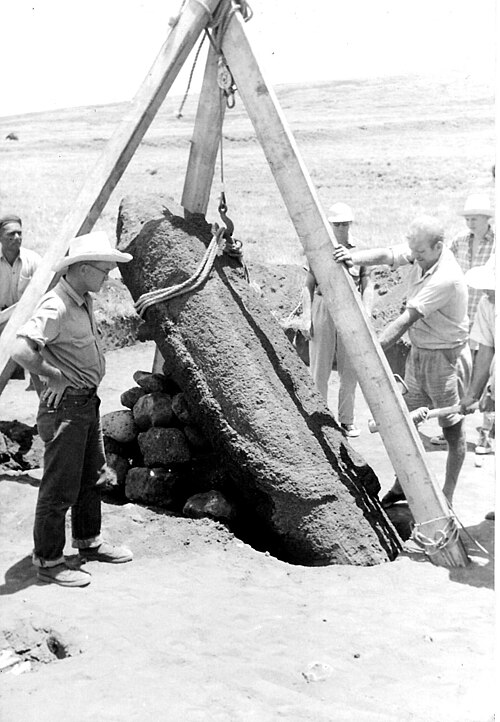
As we leave Vinapu I take one last look at the fallen moais and contemplate just how did those walls get so perfect, when none of the others did?
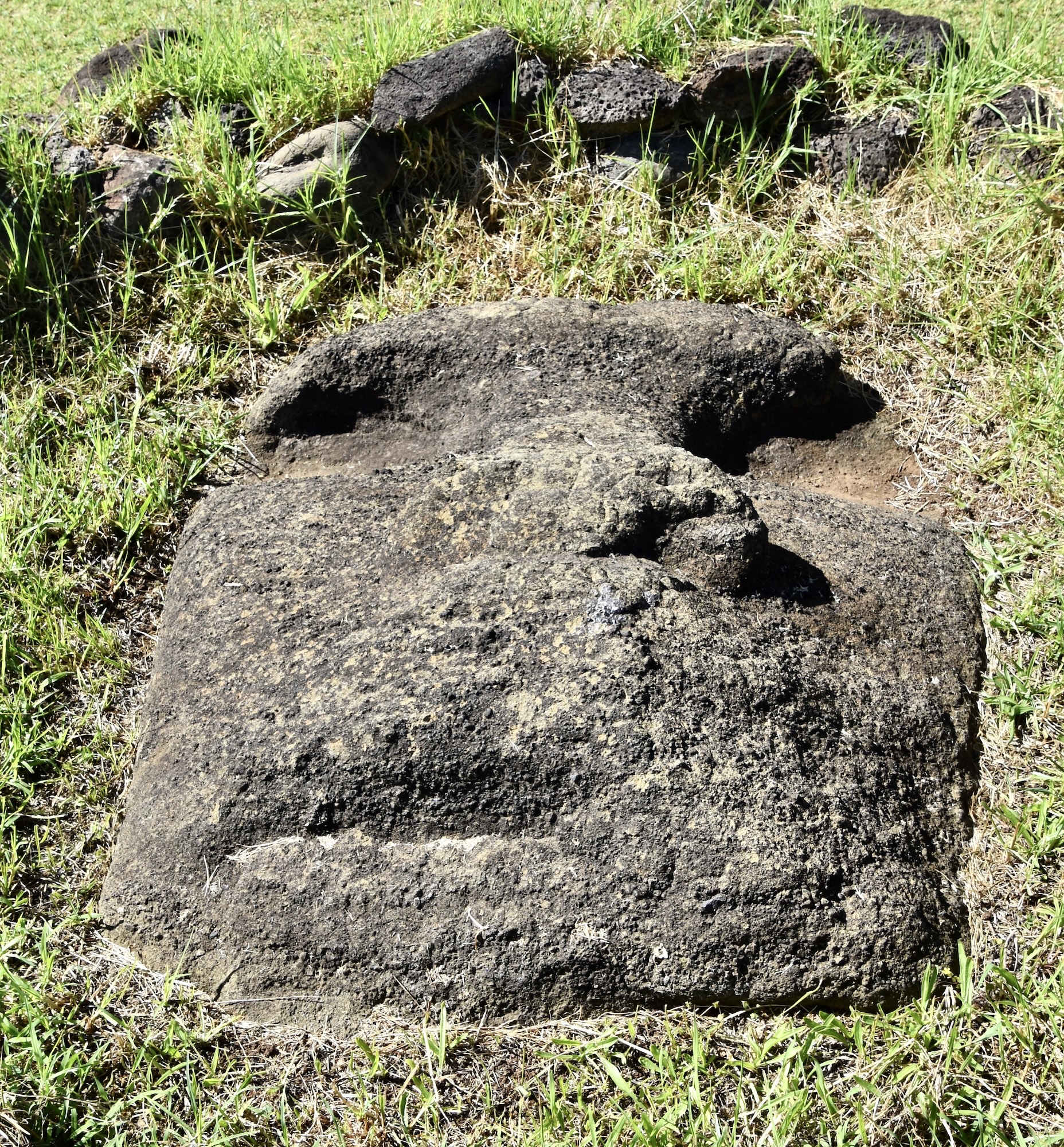
Our next site is Puna Pau which is the interior of Rapa Nui, above Hanga Roa, but first we make a short stop to visit this solitary moai which sits on private property. It has a certain solitary majesty and is one of the few that was not erected on the coast. It also acts as another myth buster. I always thought of the moais of Rapa Nui as essentially giant heads, but in reality they are representations of an entire figure. This mistaken notion arose because many of the first moais recorded by the first visitors were buried up to the neck, who thought they were seeing the entire statue.
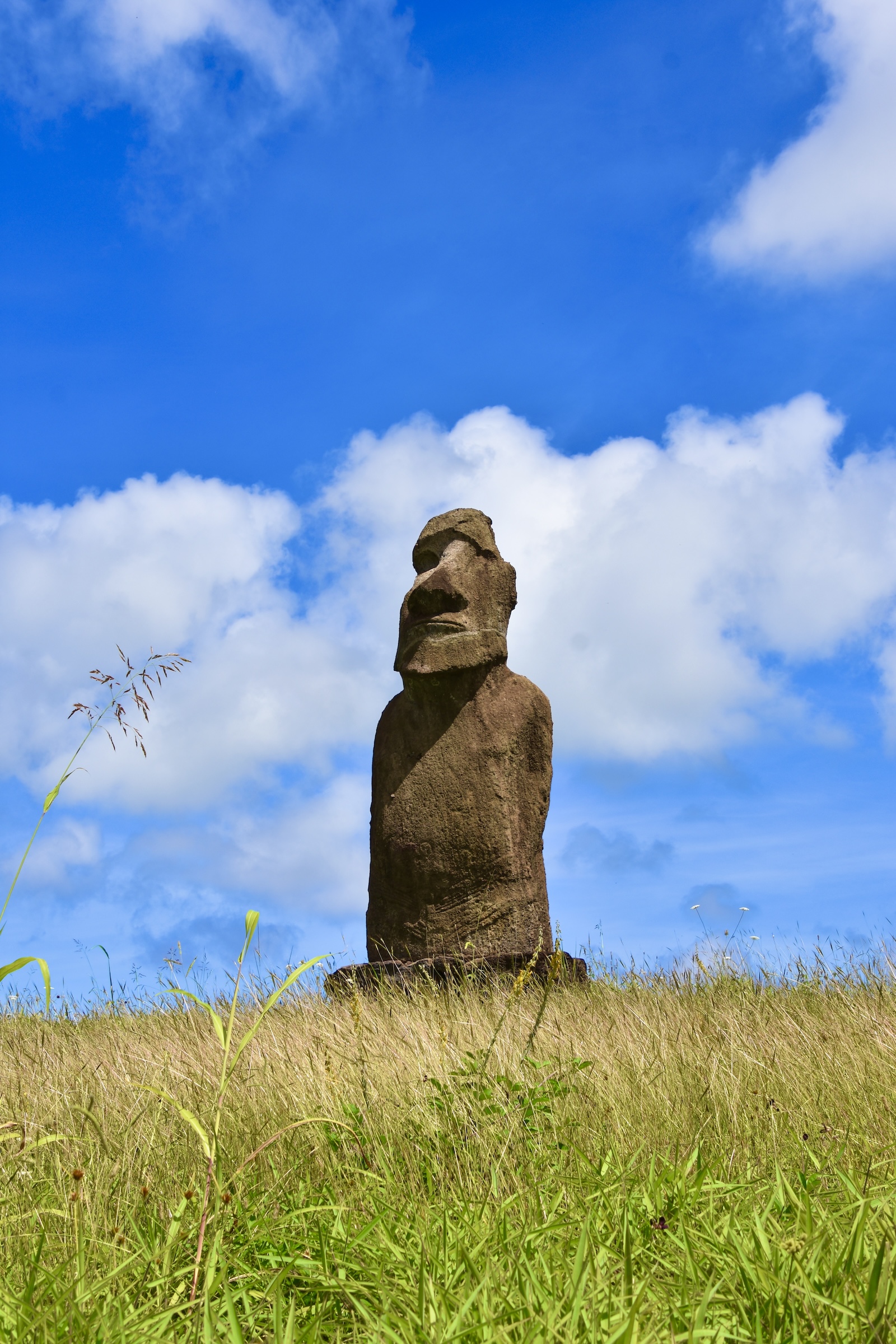
Puna Pau is not a place to see moais, but rather the quarry where the pukaos were carved.
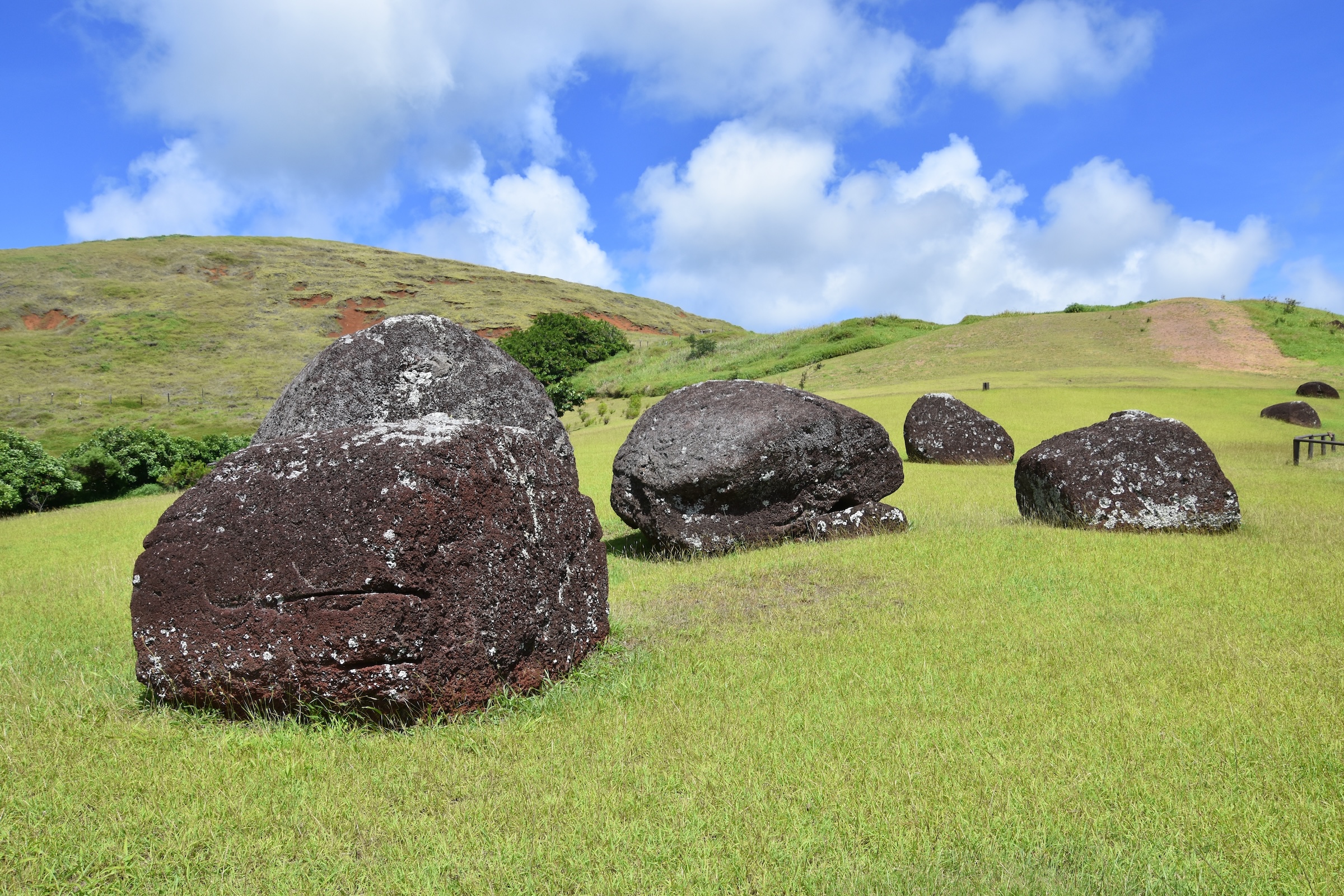
It sits inside a small volcanic crater that is littered with pukuas that didn’t make the grade.
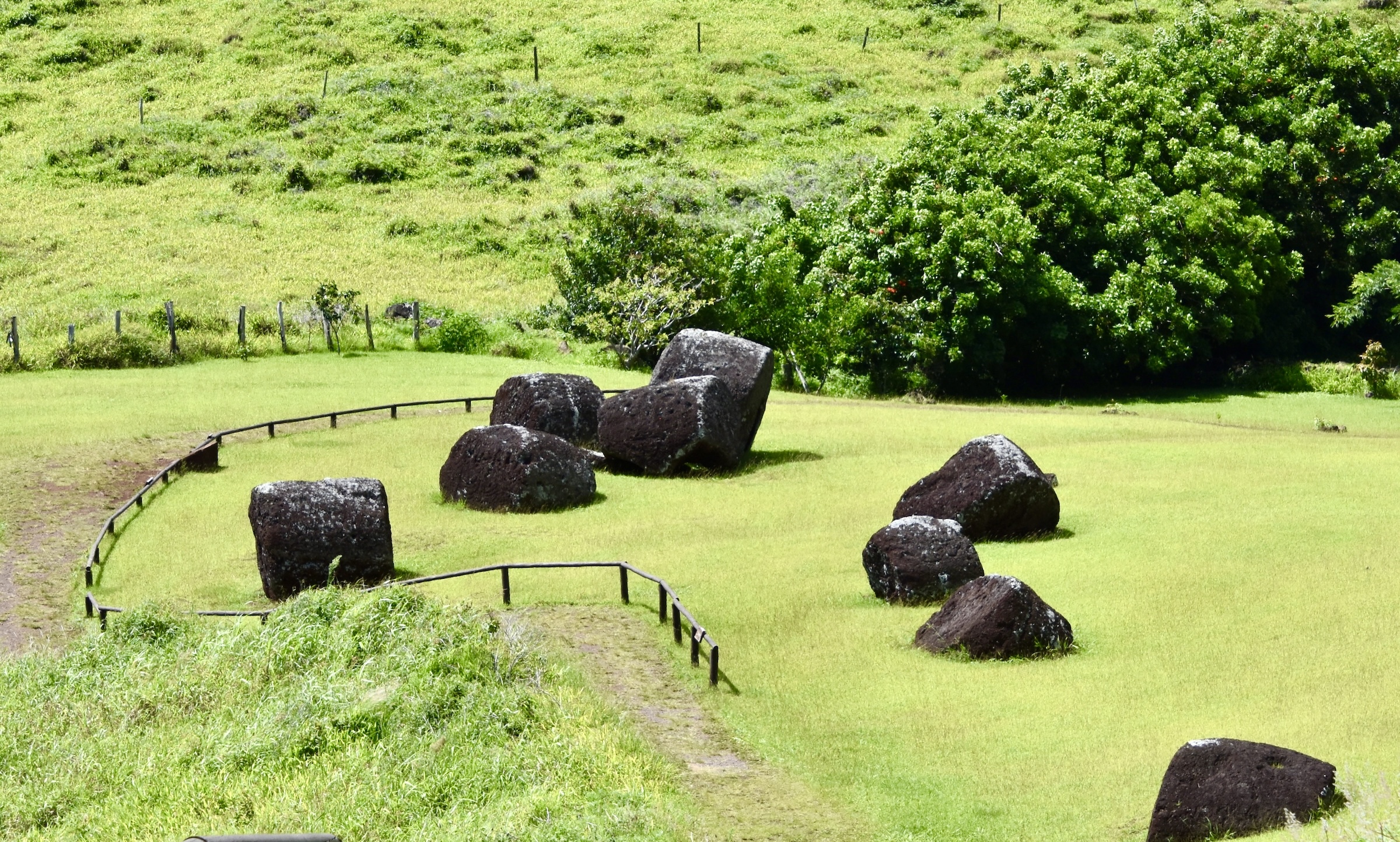
Moais of Ahu Akivi
It feels as if Alejandro is really teasing us by taking us to sites where there are no moais or if there are, they are not restored, the solitary one being the exception. But at Ahu Akiva we get to see the real deal at last. It is the only inland site that has multiple moais and of course there’s another unsolved mystery associated with them. These are the seven identical moais that are colloquially referred to as ‘The Seven Brothers’. They are all 16 feet (4.9 metres) tall and each weighs 18 tons. These moais are ones that I have seen in photos many times and trust me, seeing them in person is mind blowing.
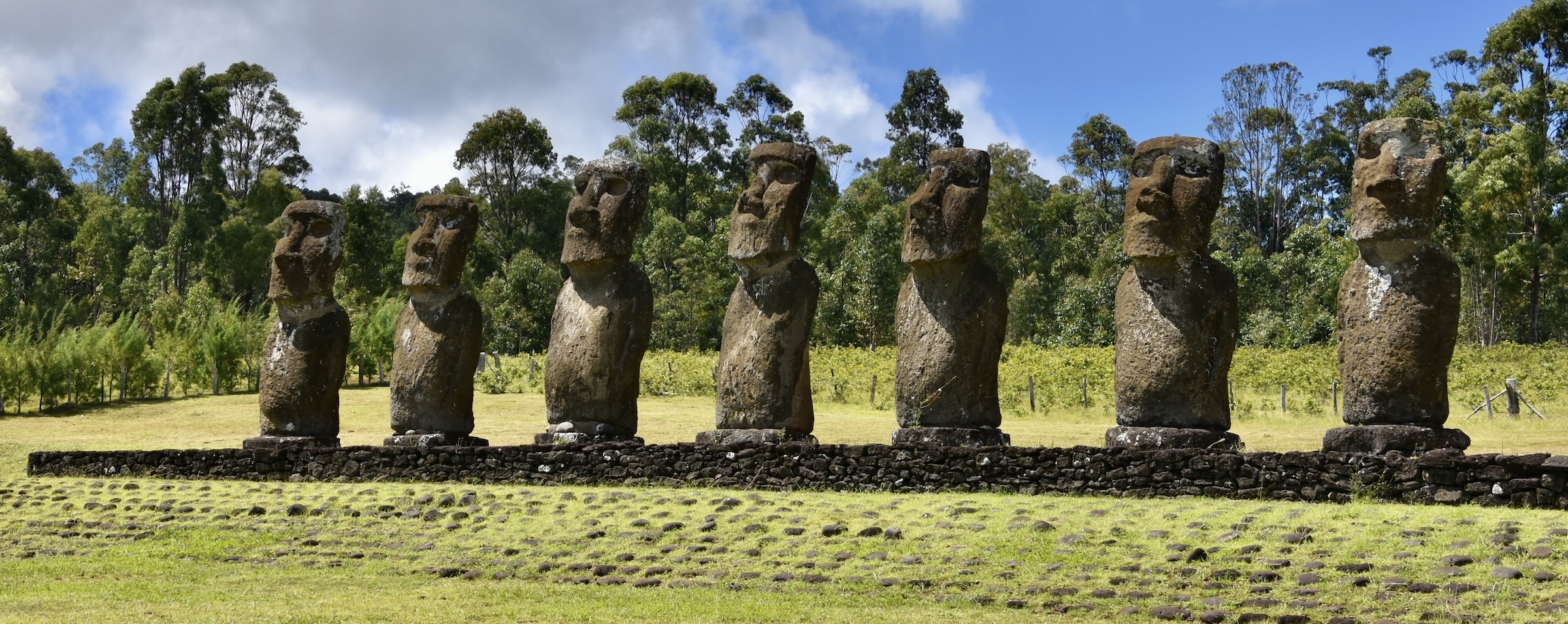
The mystery associated with these moais is that unlike any others, they face toward the sea and are astronomically aligned. At the spring equinox they stare directly at the rising sun. During the autumn equinox the sun rises exactly behind them. Why and how this precise alignment was created remains unknown.
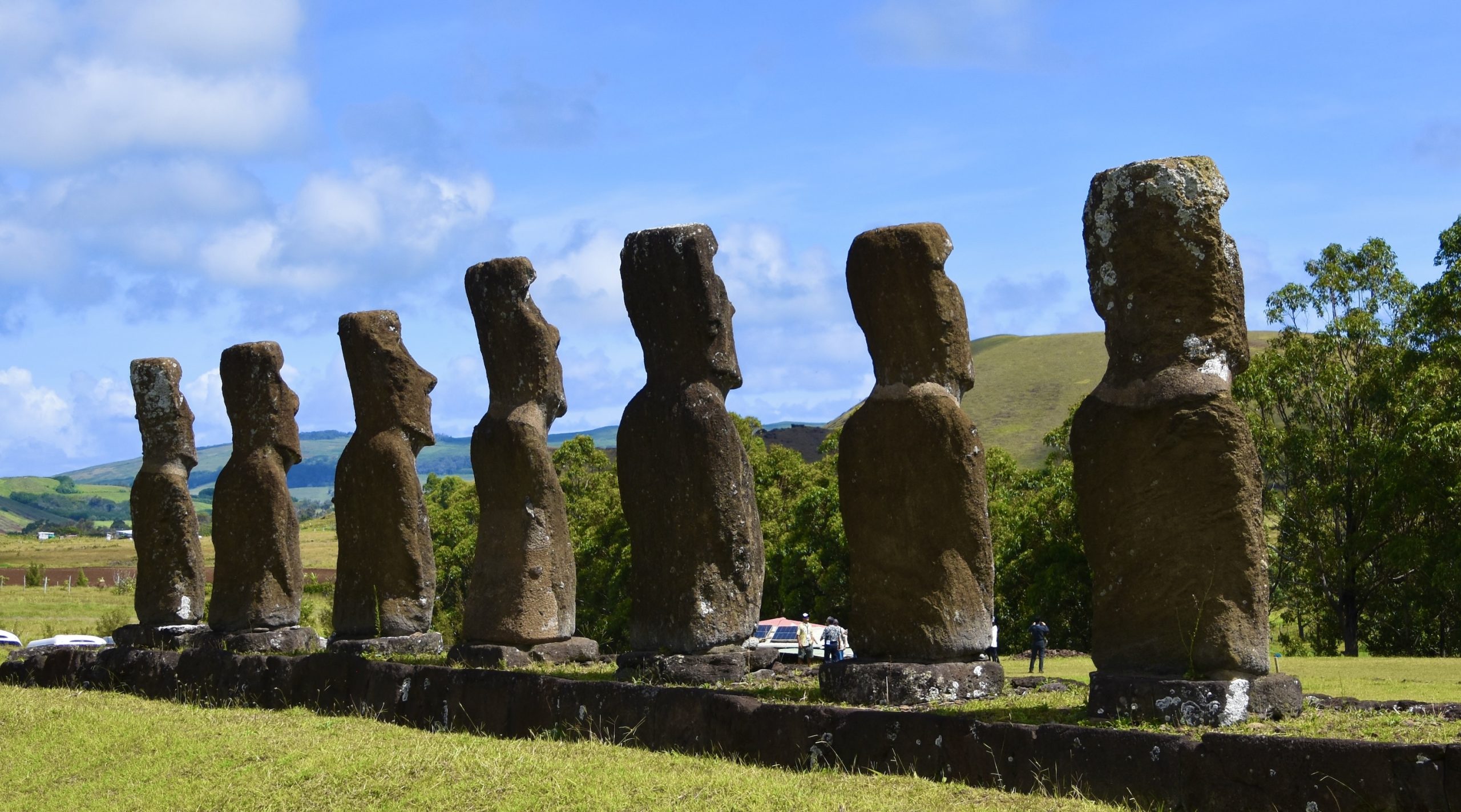
Ahu Tahai
In the last post I included a picture of the Hanga Roa cemetery with a number of moais in the distance. This was the site of Ahu Tahai where we are headed next. It contains three ahus, two of which have solitary moais and the other multiple figures.
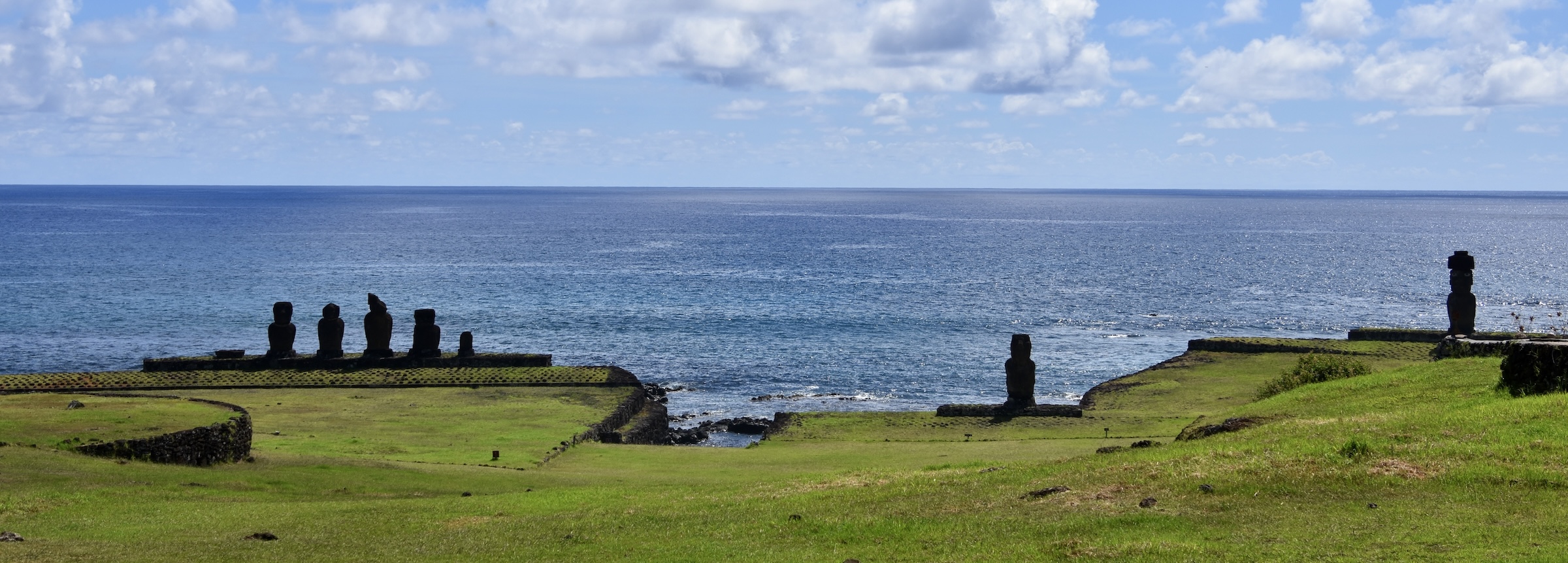
The site was restored by William Mulloy in 1974 and features probably the most complete restoration of any of the moais on Rapa Nui. This is Ko Te Riku, complete with his pukao and eyes. You can see from the shadow that I was facing the sun which made for a difficult photo.
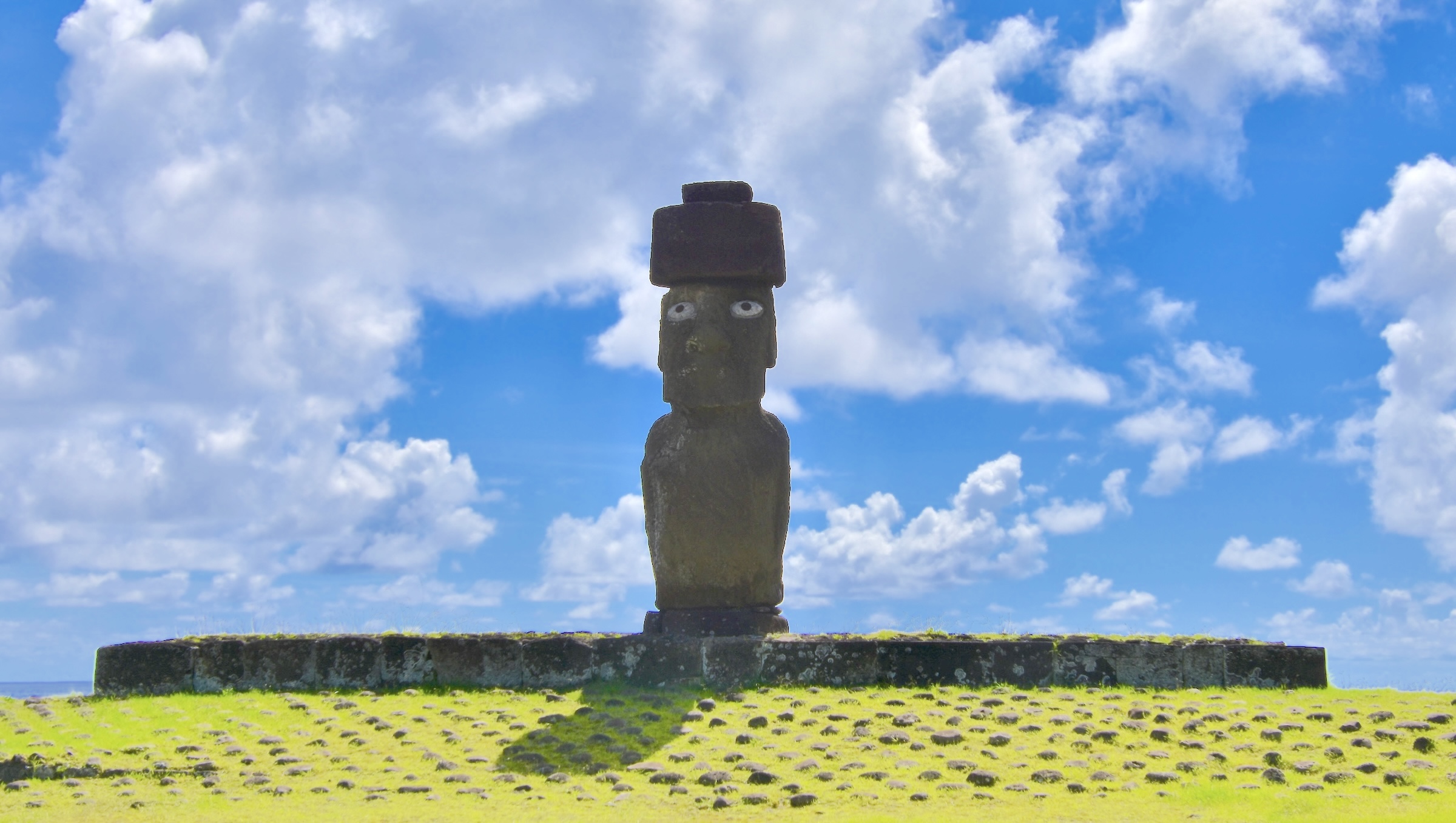
This photo by Bjorn Torrissen gives a better view. – pretty, darn amazing.
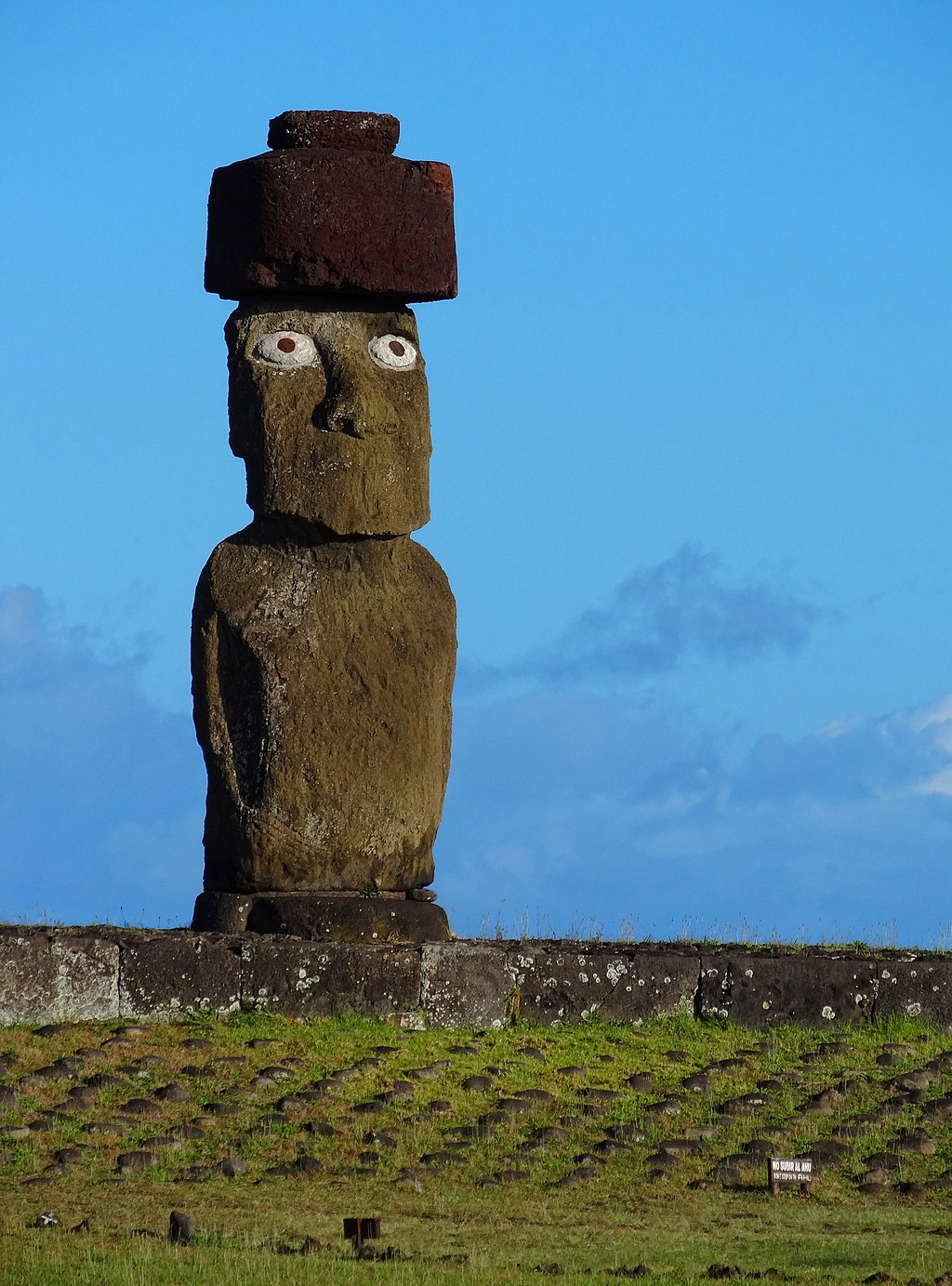
This is a photo of the other moais at Ahu Tahai which pale in comparison to Ko Te Riku.
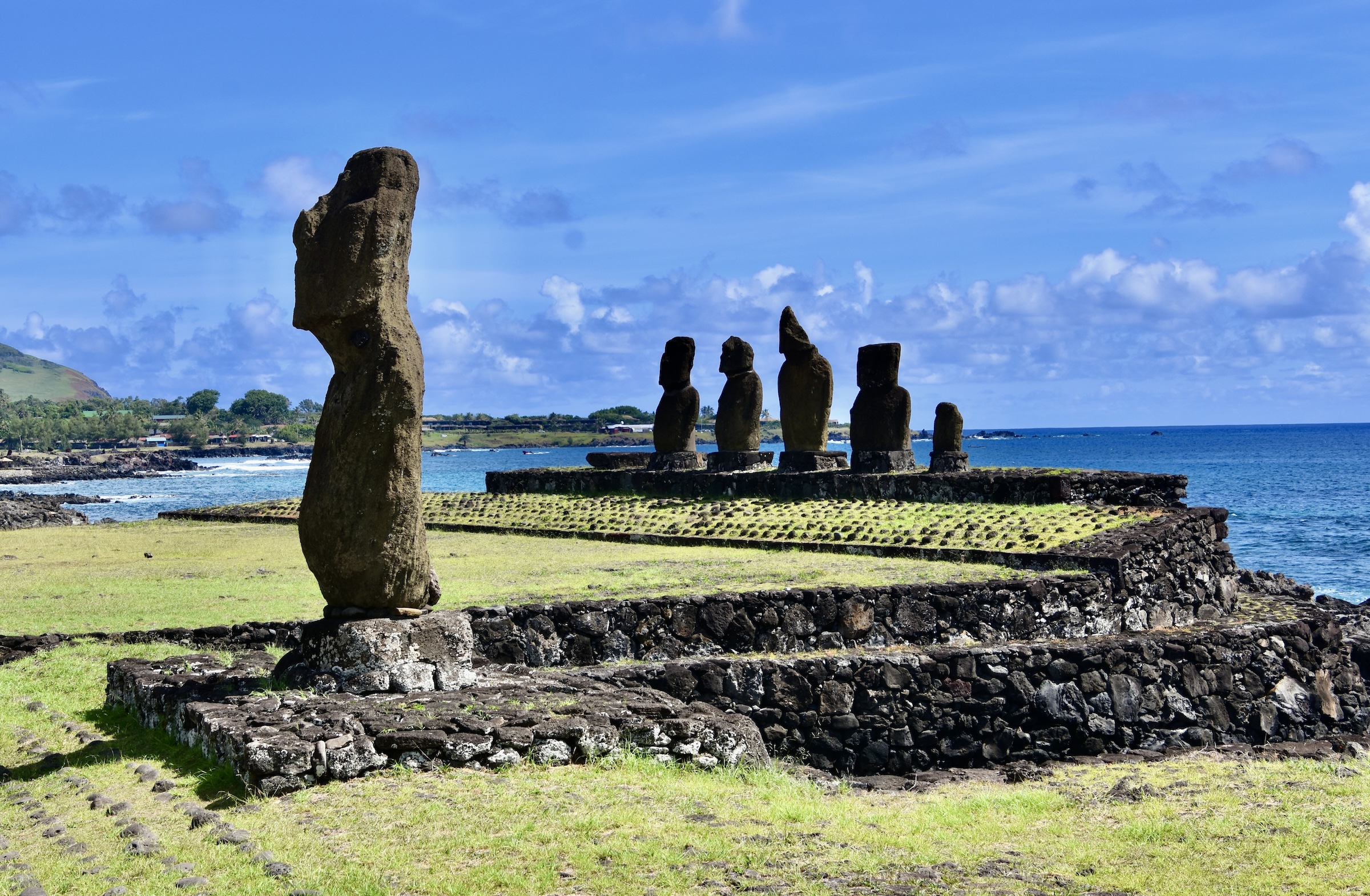
Alejandro points out what is believed to be the oldest of all the moais on Rapa Nui which is much more primitive in style than the other moais we have seen.
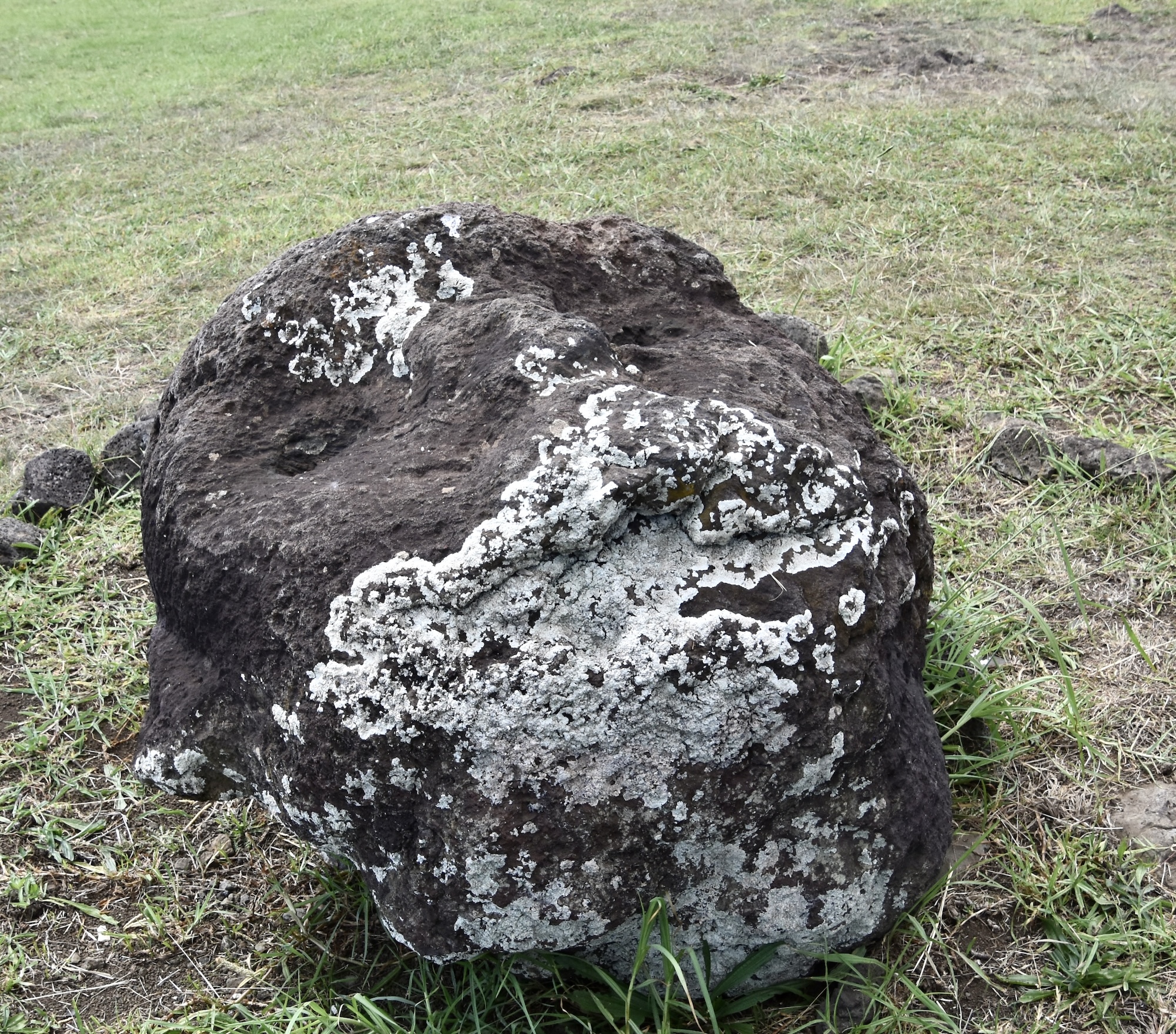
Also at this site are the graves of William Mulloy and his wife. No man has done more to put Rapa Nui on the tourist map than Mulloy. Without his efforts the moais would have remained toppled and of far less interest to outsiders. It is only appropriate that he should lie with his beloved recreations.
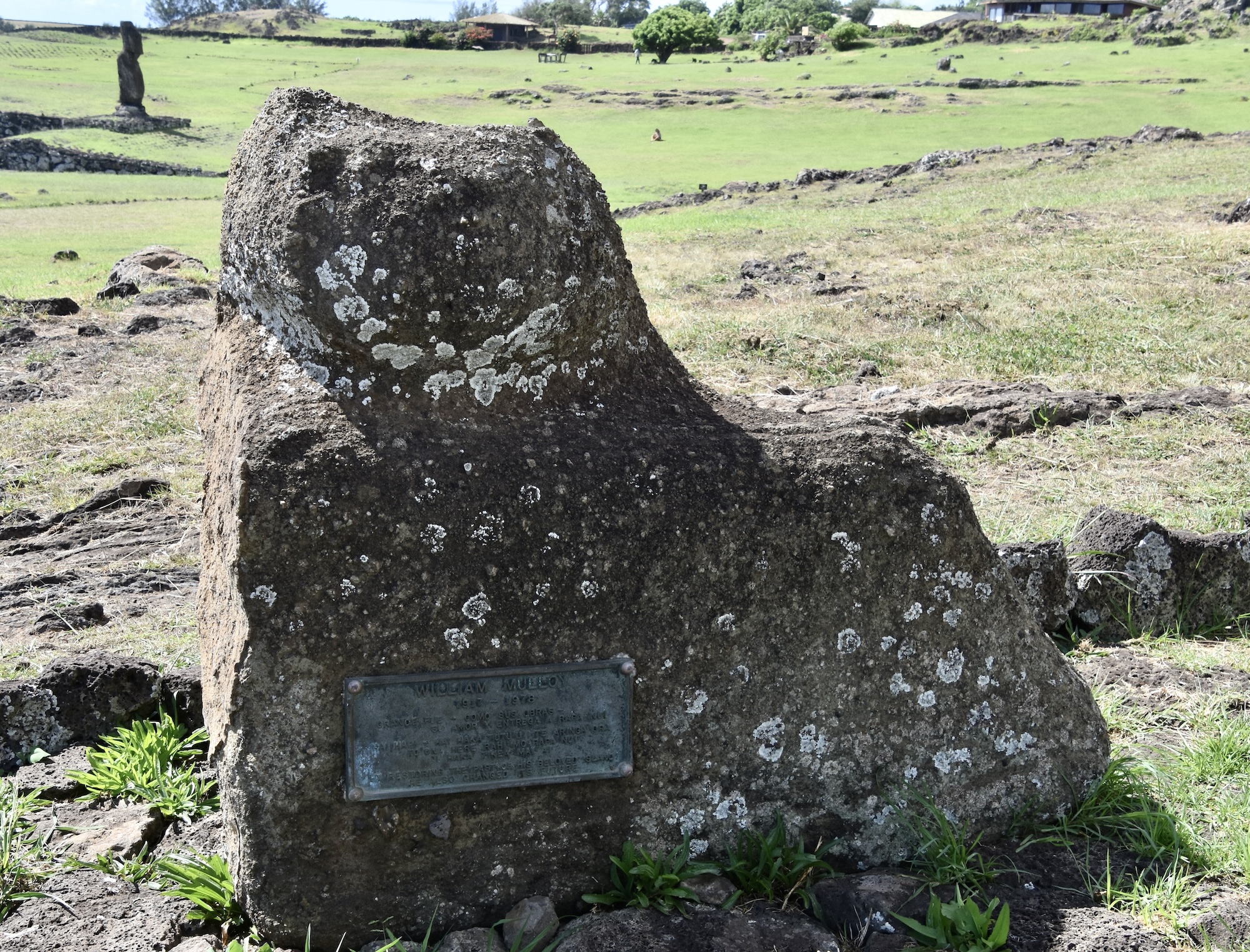
We weren’t the only visitors to Ahu Tahai.
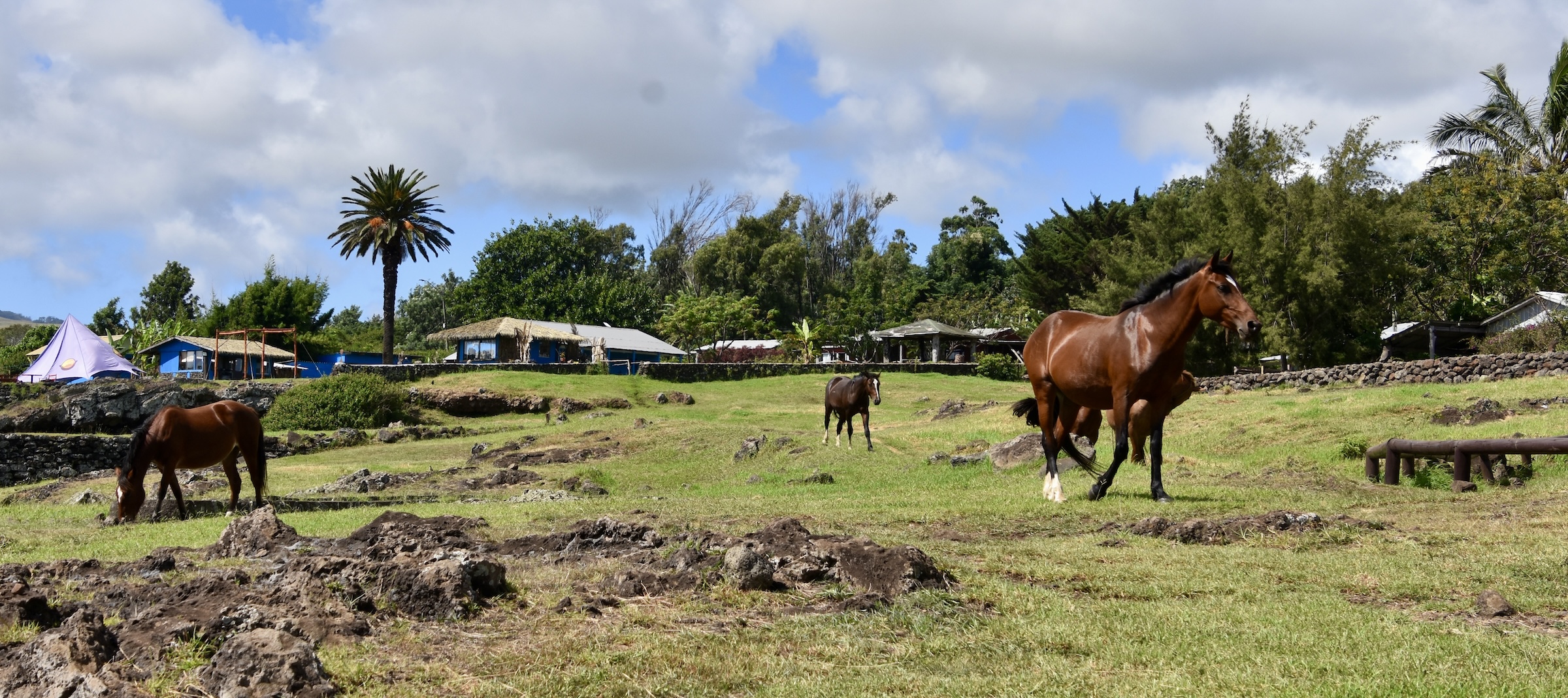
Vai Hu

Ahu Vai Hu is an example of a Rapa Nui archaeological site where the moais have not been re-erected and you can see them as they would have appeared to the first Europeans to visit after that statue toppling began in the late 18th century. Alejandro has no doubt that this was the consequence of the tribal war between the Long-Ears and the Short-Ears wherein the Long-Ears were decimated. The moais were either toppled by the victorious Short-Ears as they represented Long-Ears ancestors or by the Long-Ears who believed that their ancestors had forsaken them. Yet another Rapa Nui mystery.
There is also a small reconstructed family compound at Vai Hu where Alejandro shows us how the Rapa Nui people grew taro using raised beds.
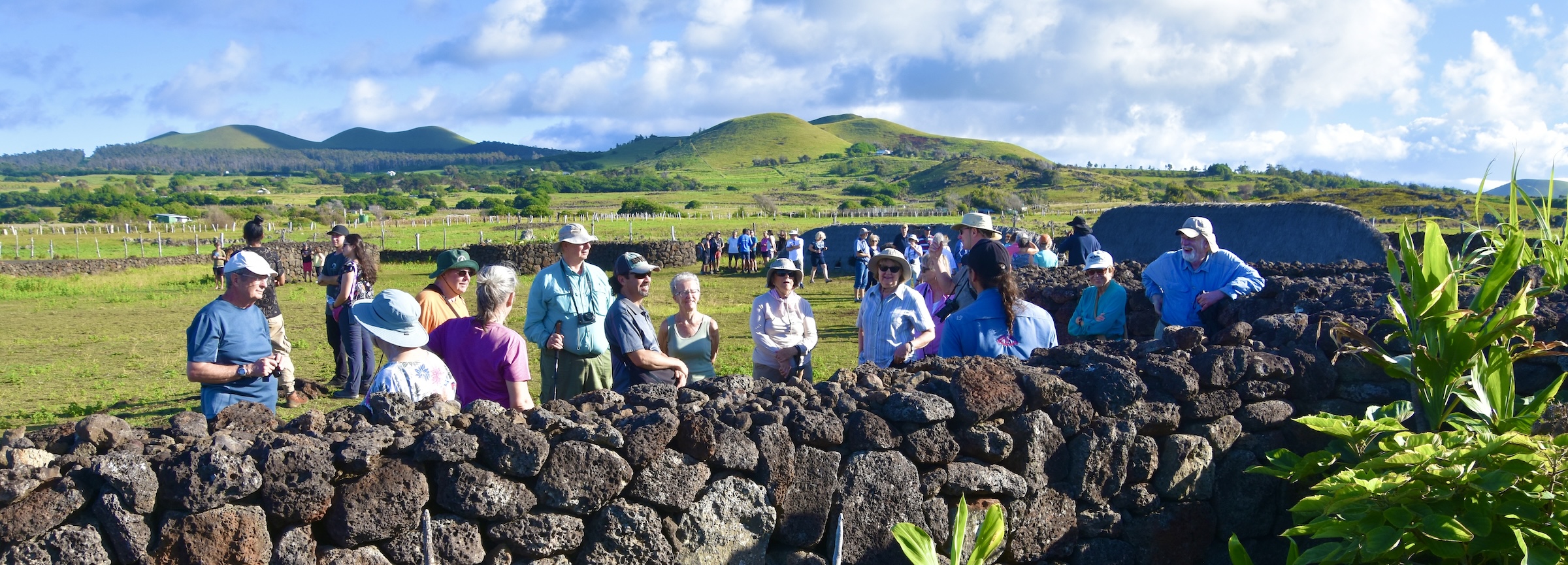
And believe it or not, this was a chicken coop. The chickens would wander around during the day and be put back in the coop at night with a rock blocking their escape.
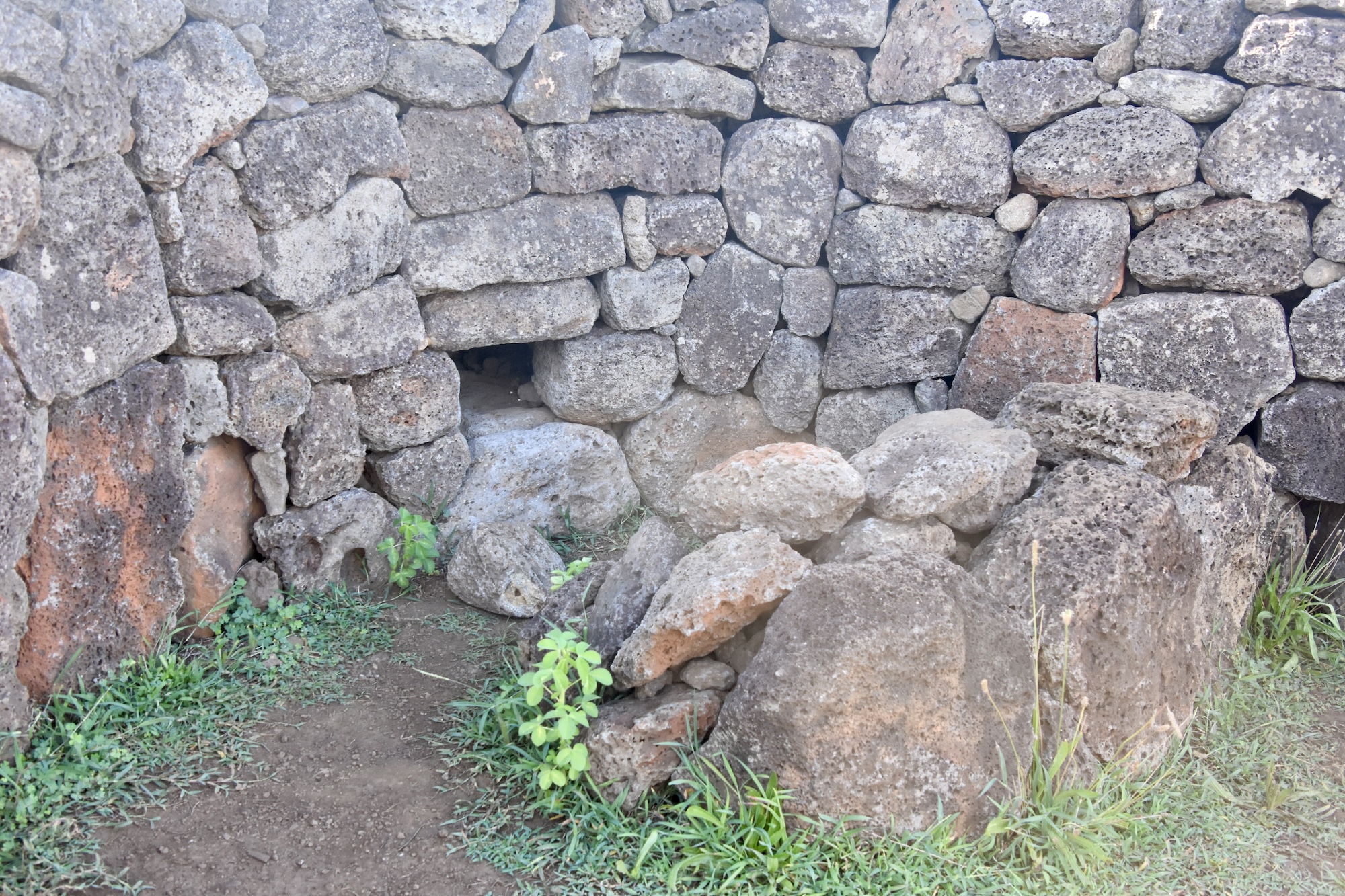
Ahu Akahanga
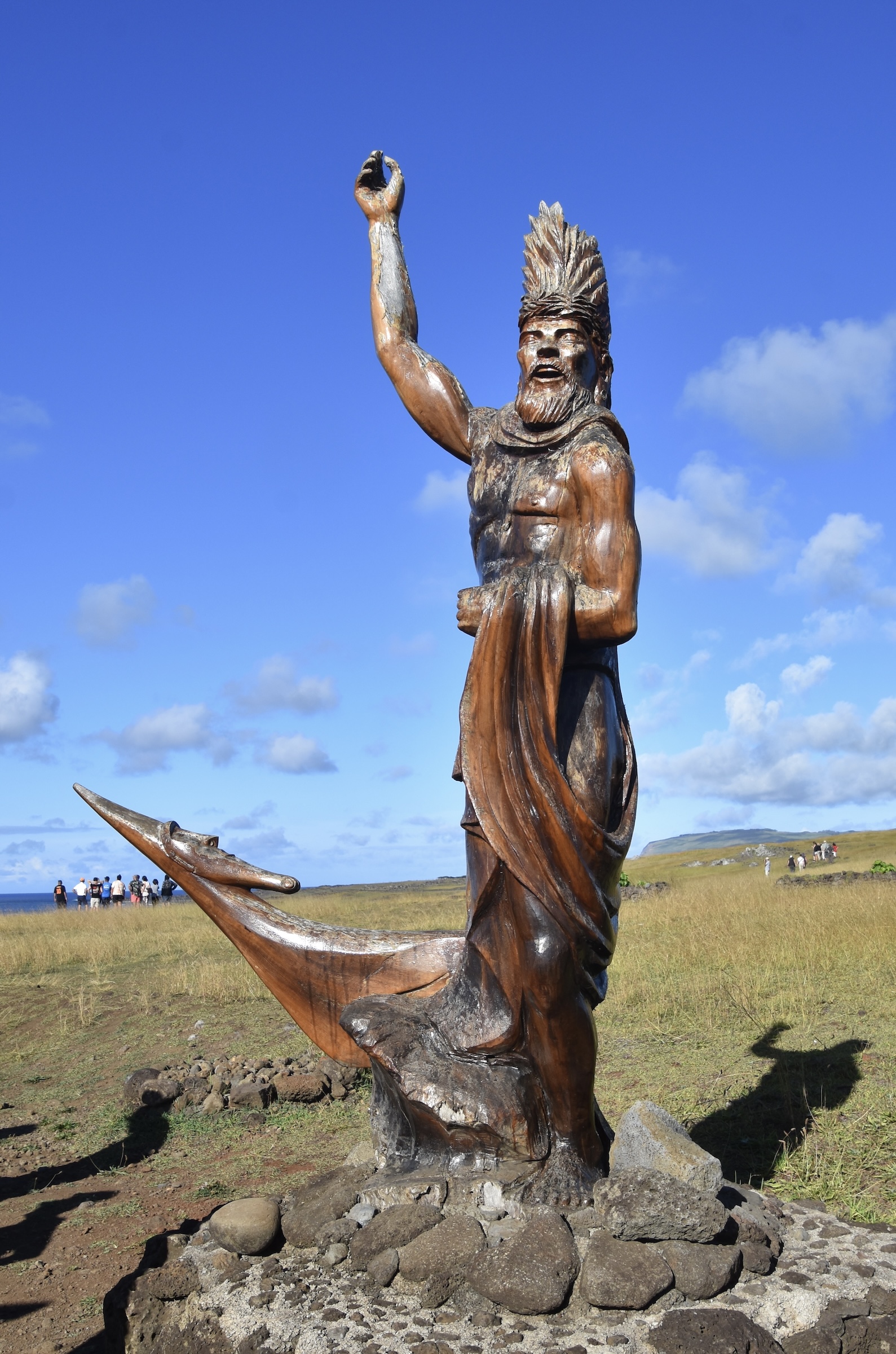
Our next stop is Ahu Akahanga which is one of the most sacred sites in Rapa Nui as this is where, according to legend, Hotu Matu’a the founder of the place, is buried, although to date no evidence of that has been found. What has been found are the remnants of a small village and this structure which Alejandro described as the astronomer’s lookout post.
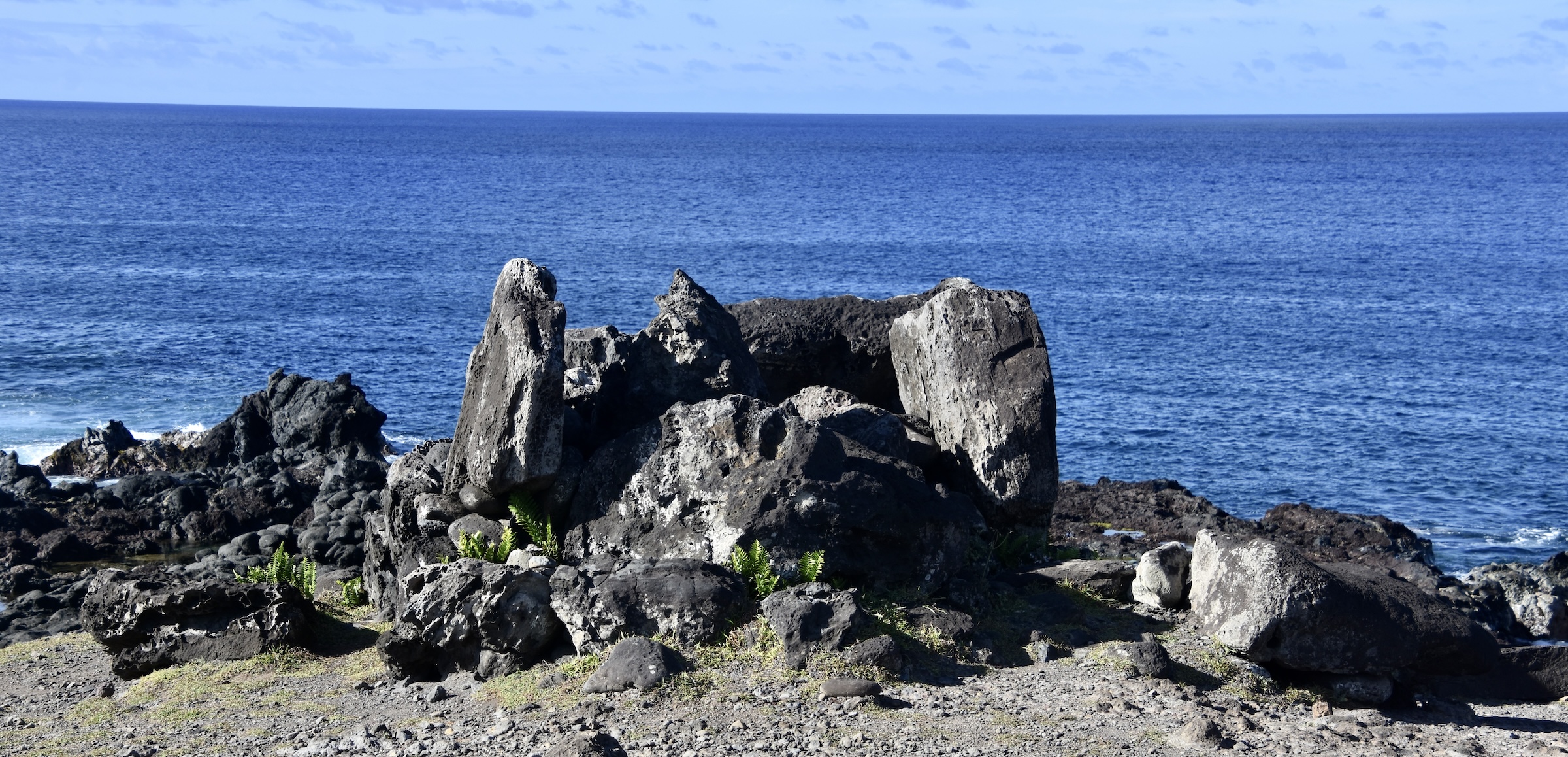
There is also a small cave that was used as a storage spot.
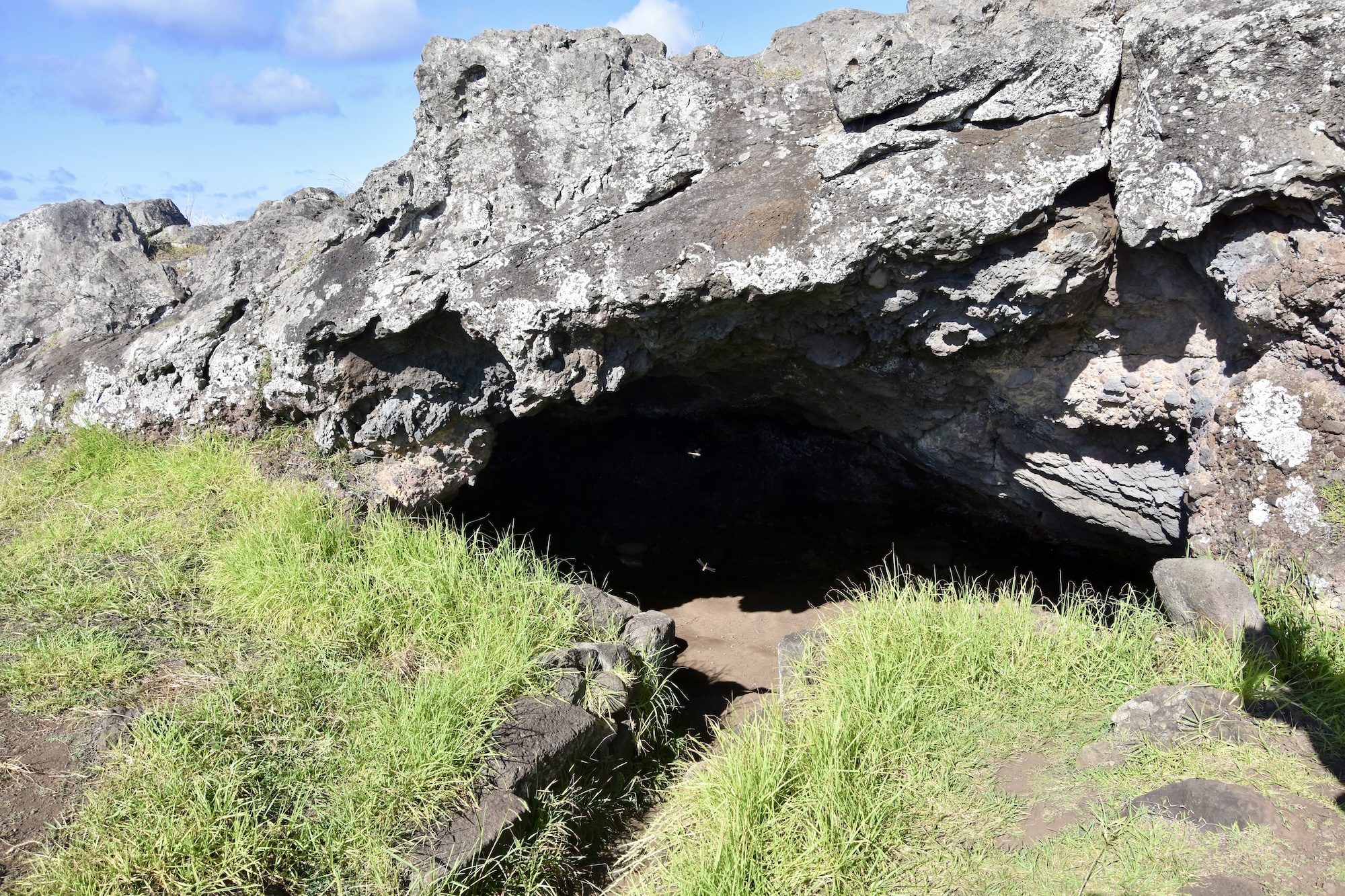
However, what Ahu Akahanga is best known for are the number of toppled moais.
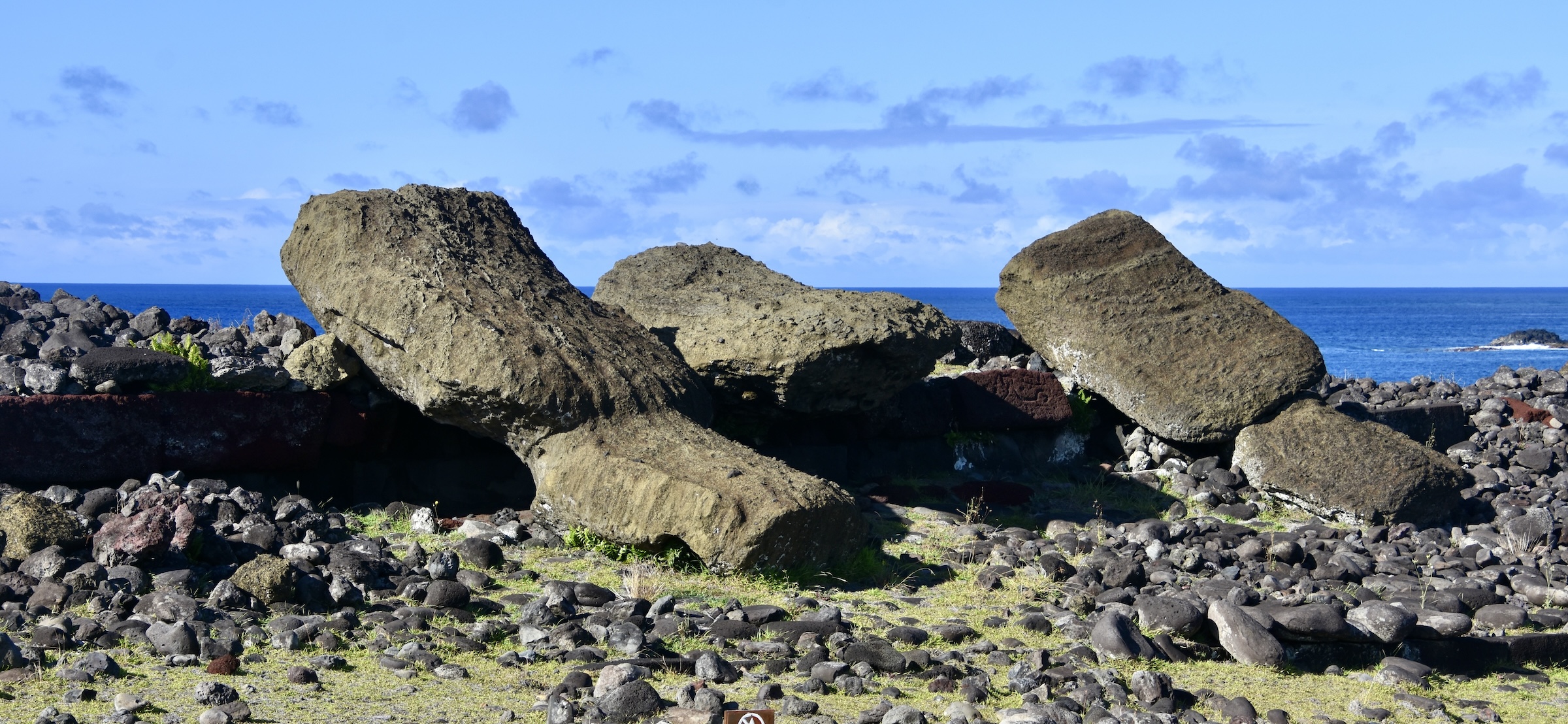
They are literally scattered throughout Ahu Akahanga and unlike other toppled moai sites, not all have been pushed face down; some stare eyeless at the sky above. There are also pukoas strewn around, some of which have inscriptions in the undeciphered Rapa Nui proto-writing. If there ever was a place were the adage “How the mighty have fallen” was appropriate, it is here. This is a small gallery of some of the fallen giants. Double click to open one and double click again to enlarge.
Rano Raraku
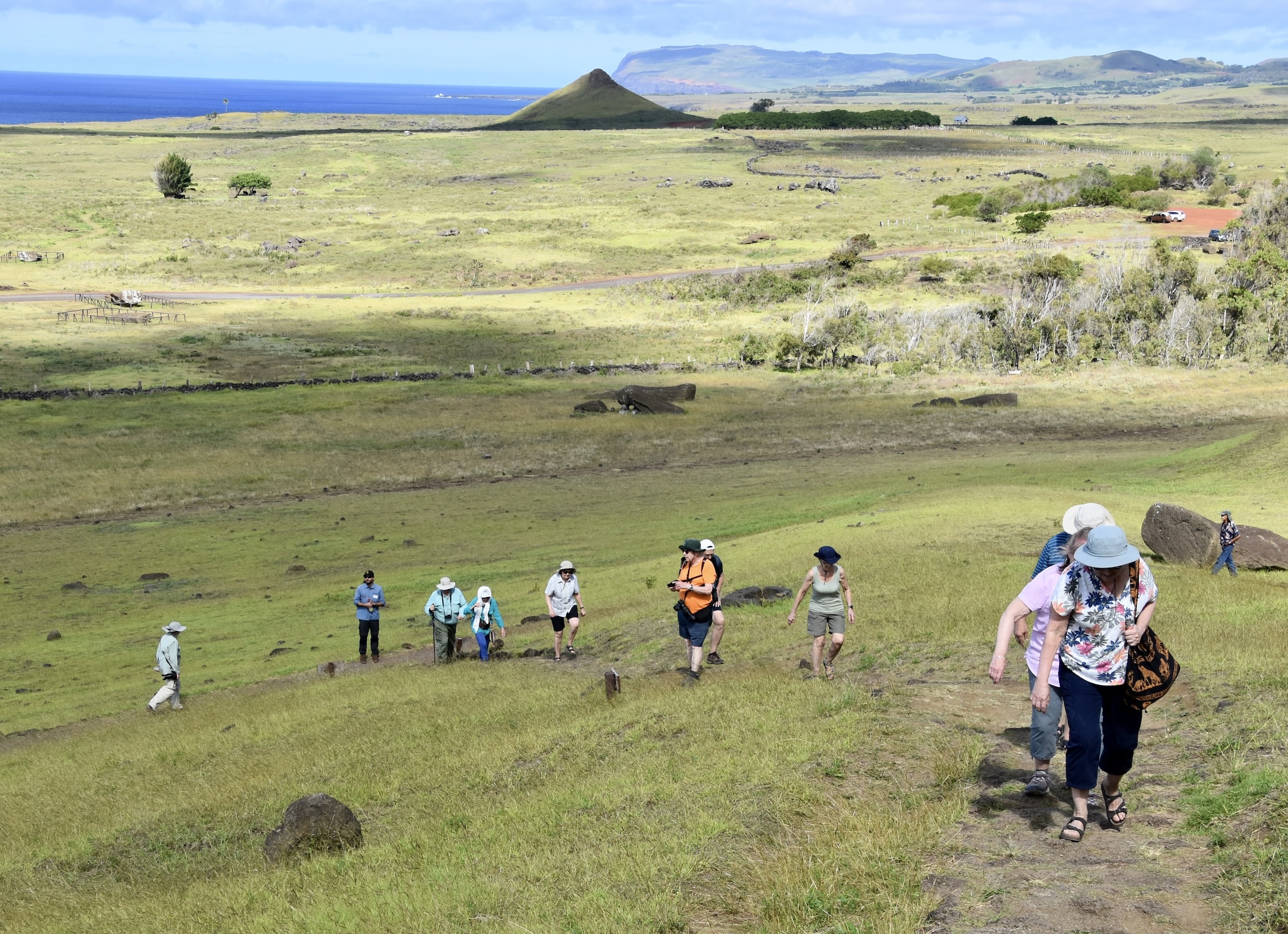
The moais at Rano Raraku and nearby Tongariki are without question the highlights of any visit to Rapa Nui. There are over 400 moais at Rano Raraku which was the quarry in the flank of Rano Raraku volcano where almost all of them were carved. This is where the idea of the moais as giant heads first appeared as many of them are buried up to the neck. You visit them by following a well defined path that will take you past the highlights. This will be one of the most memorable walks you will take in your life as you stand as close as you can to these most iconic of all ancient mysteries.
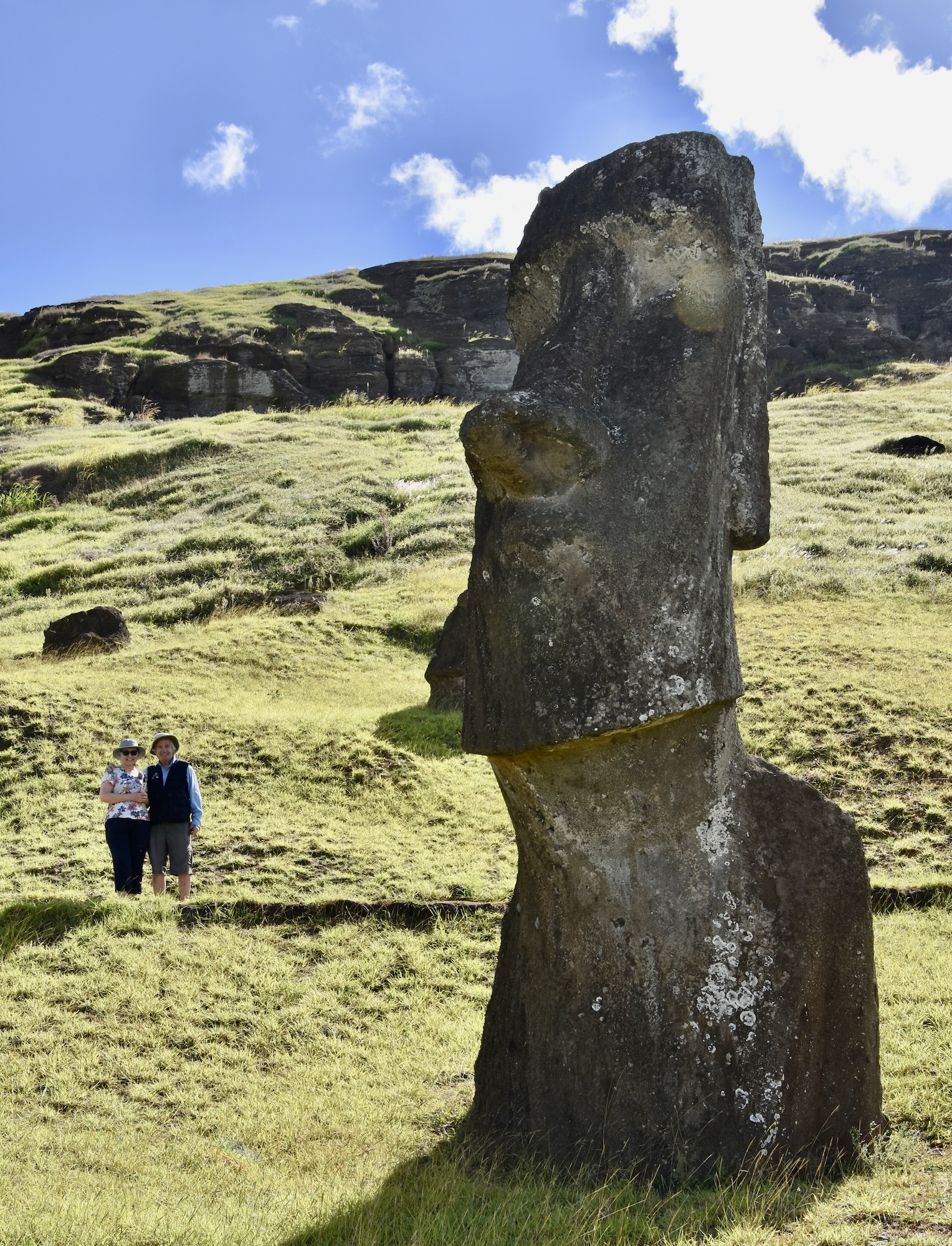
The path winds gradually uphill to the actual quarry site with the half-buried moais all around in what might be a Salvador Dali painting come to life.
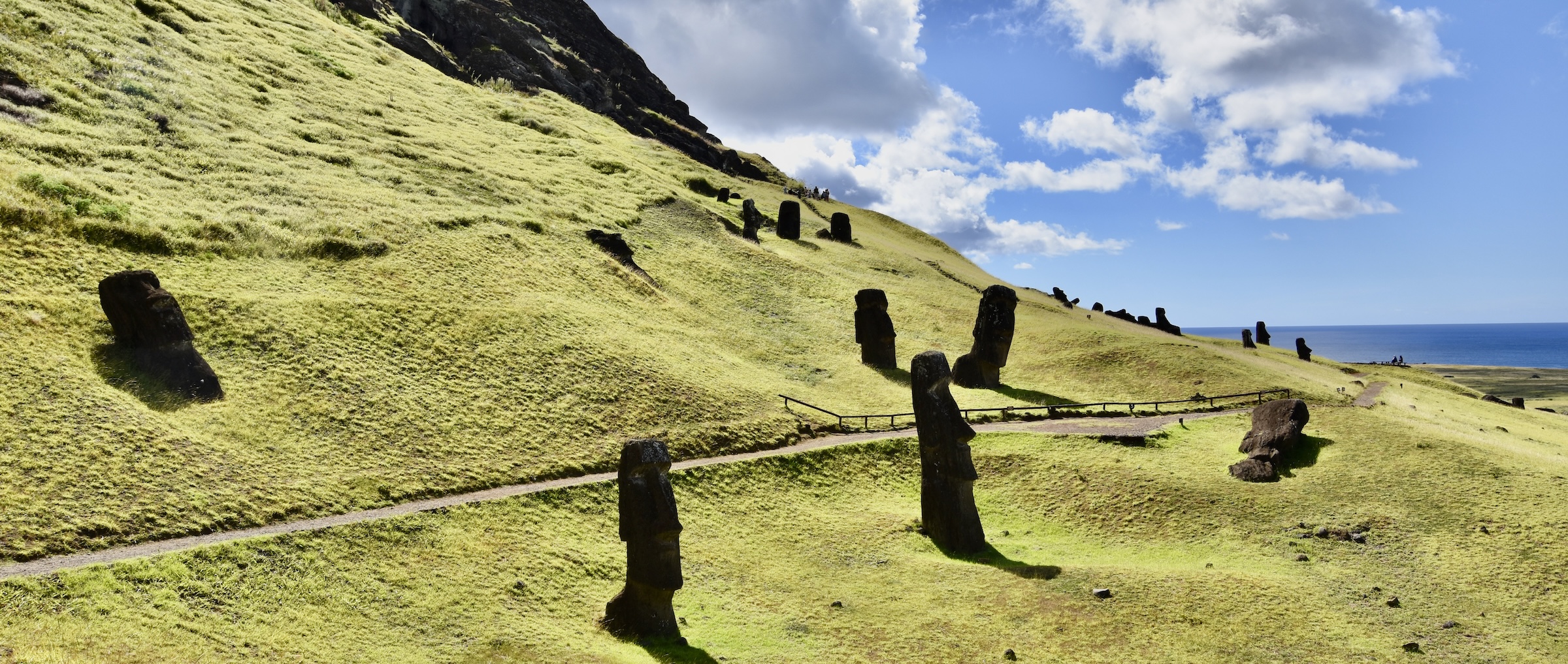
This is just below the quarry which actually was the slicing up of the volcanic tuff on the side of the cliff rather than excavating a hole in the ground which is what we usually associate with a quarry.
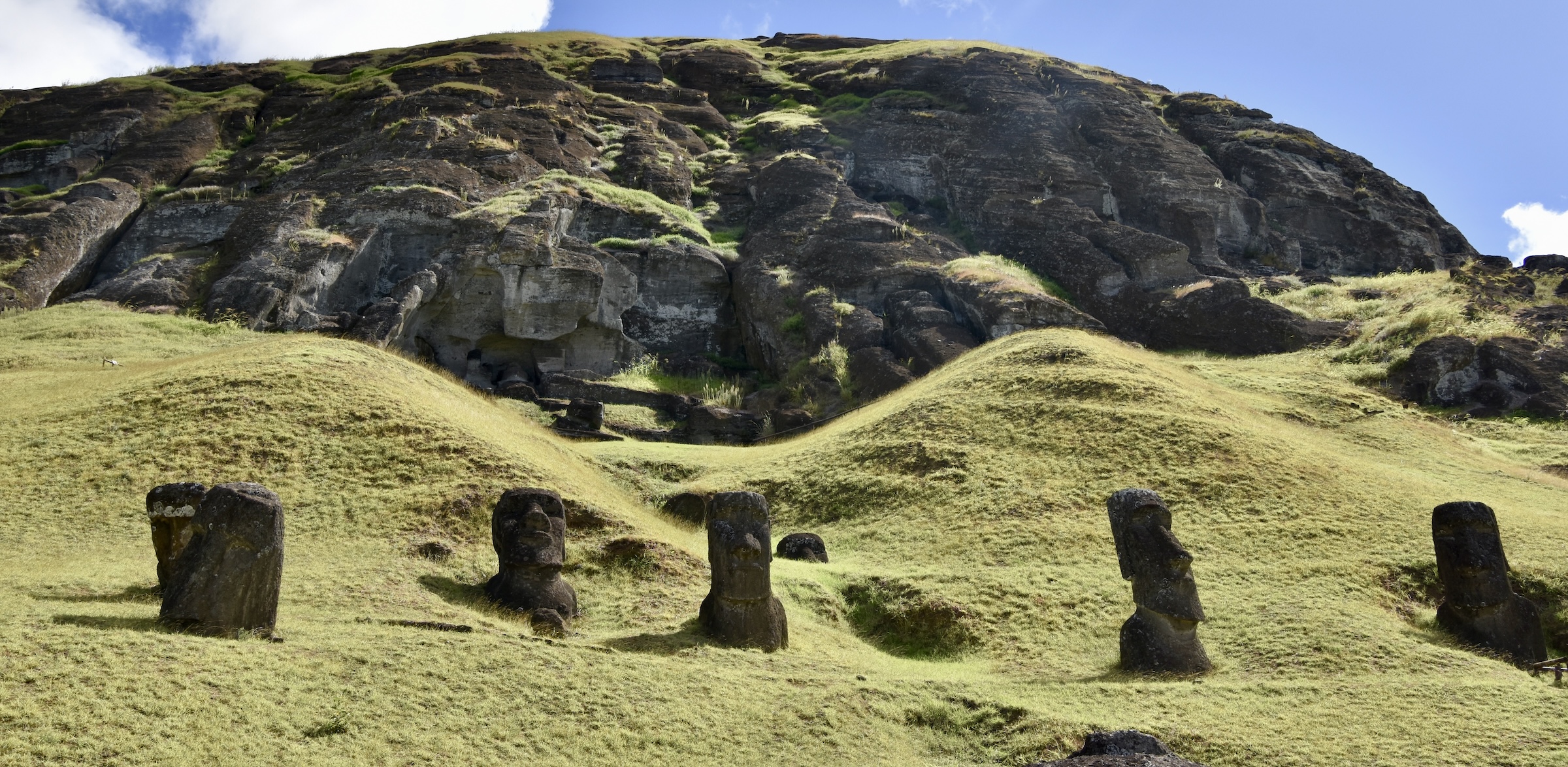
Here we find the largest moai ever carved, Il Gigantico which is more than 10 metres (33 feet)tall. So big in fact that he never was able to arise and take his place among the other giants.
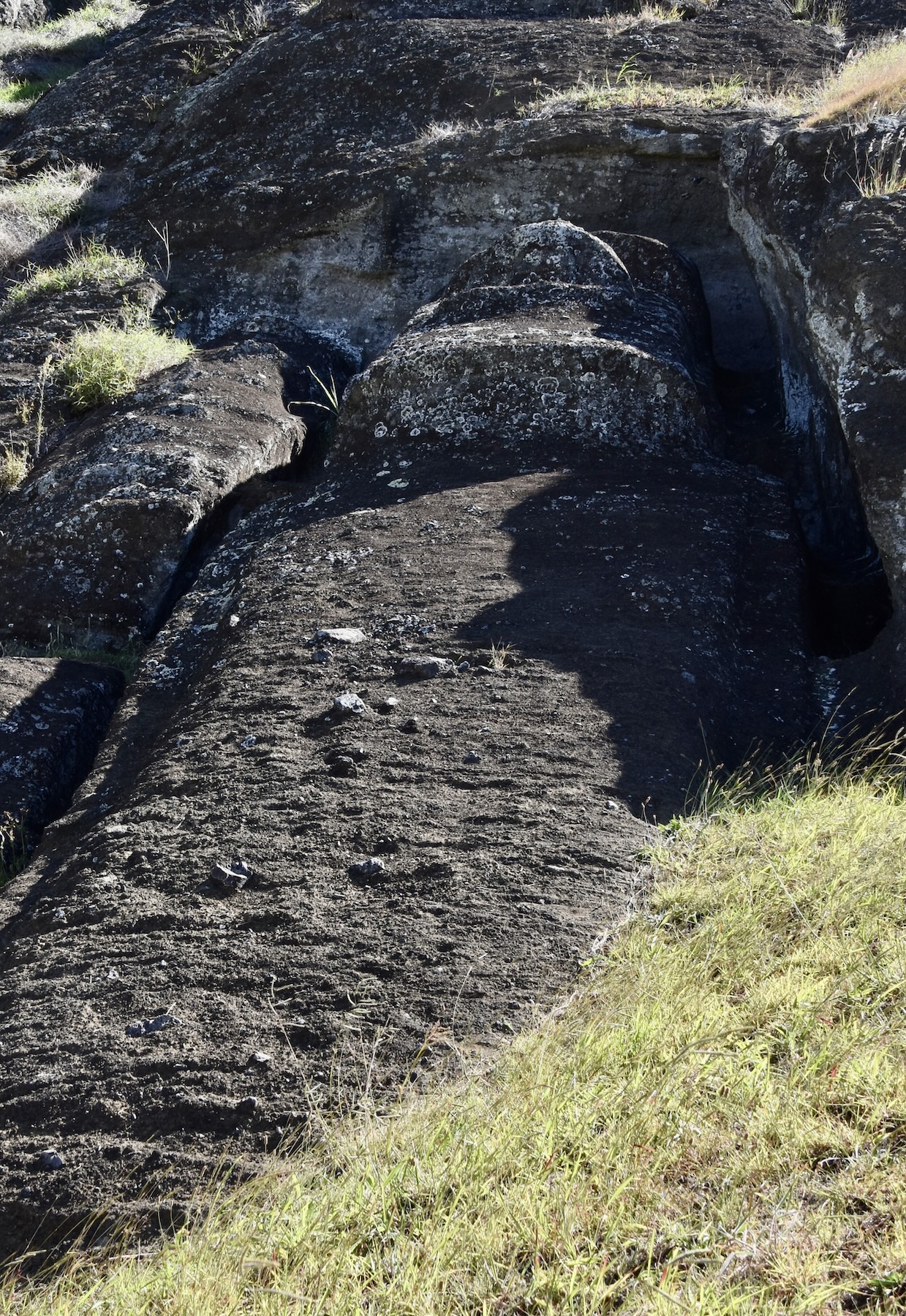
From the high point of the path you can look down at the Tongariki site on the coast, which is where we are headed next.
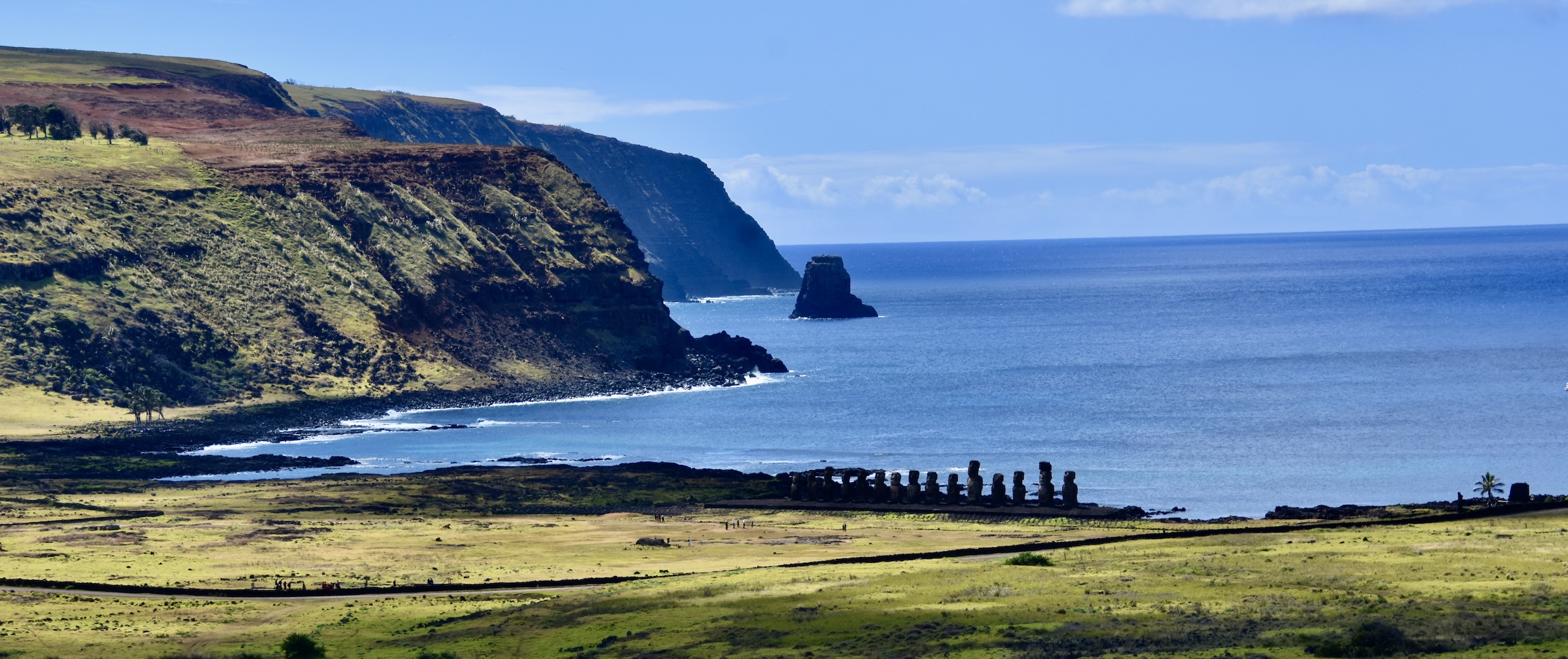
Up here Alejandro points out the one and only tiki ever carved on Rapa Nui. Why these islanders decided to abandon this style of sculpture which is common everywhere else in Polynesia in favour of the moais is unknown, but I for one am glad they did.
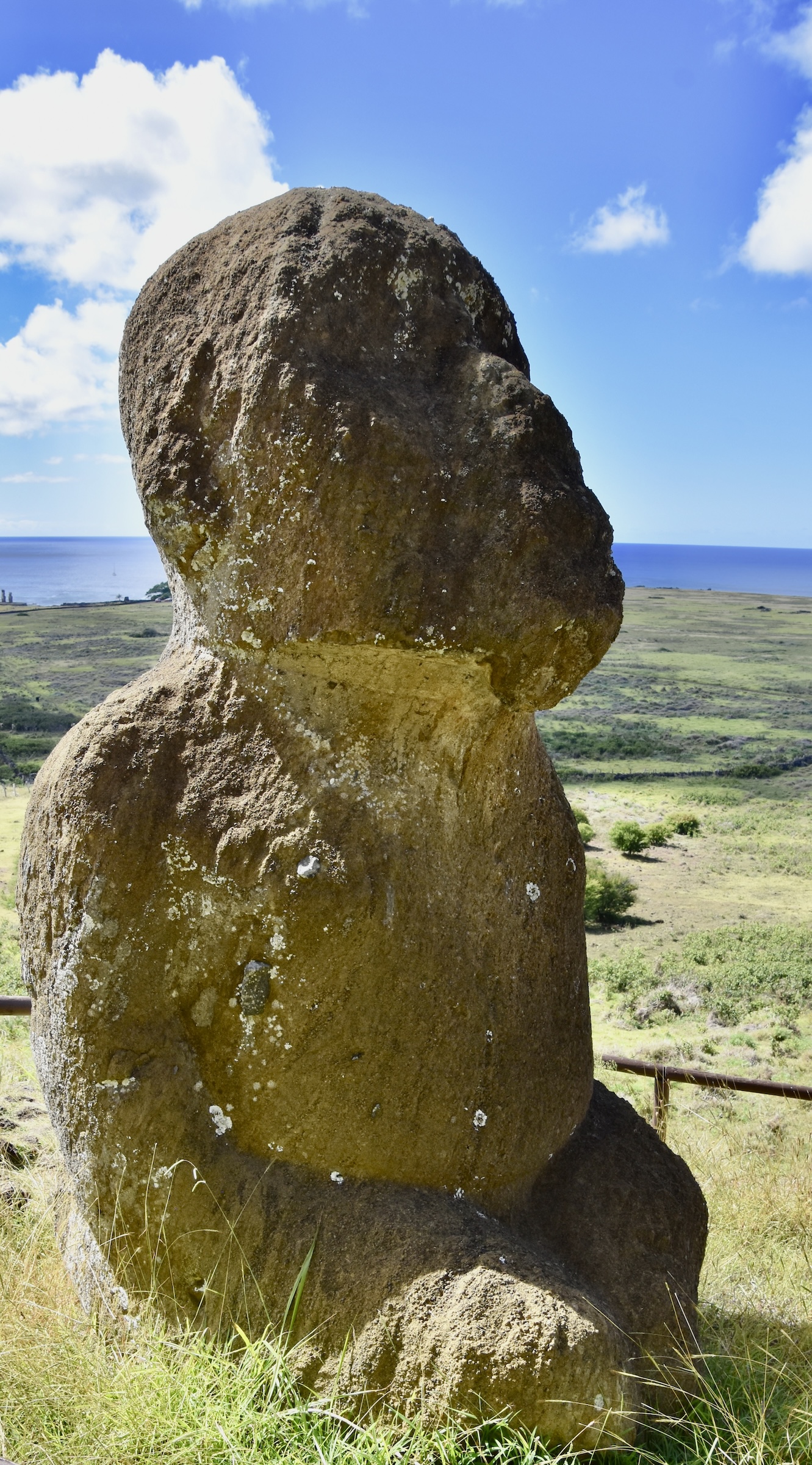
Moais of Ahu Tongariki

Ahu Tongariki is the largest and most impressive of all the Rapa Nui sites with fifteen quite distinct moais of various sizes. It is the site that most people bring to mind when they think about what they want to see when they come here. Yet, these figures did not exist as we are seeing them today until 1996 and the site wasn’t definitively complete until 2006. While the moais were toppled during the Rapa Nui civil war, they would have been much as we saw at Vai Hu and Akahanga, but for a massive tsunami in 1960 that completely destroyed the site and scattered the moais up to 100 metres from the ahu.
It was through the efforts of the government of Japan that Tongariki was restored to its current state which was an incredible act of generosity for which the Japanese asked one favour – could they replicate some of the moais for a park in Japan? Up until then Rapa Nui had absolutely discouraged replication of the moais, but how could they refuse this request?
This is Sun Messe Nichinan Park in Miyazaki Prefecture, Japan.
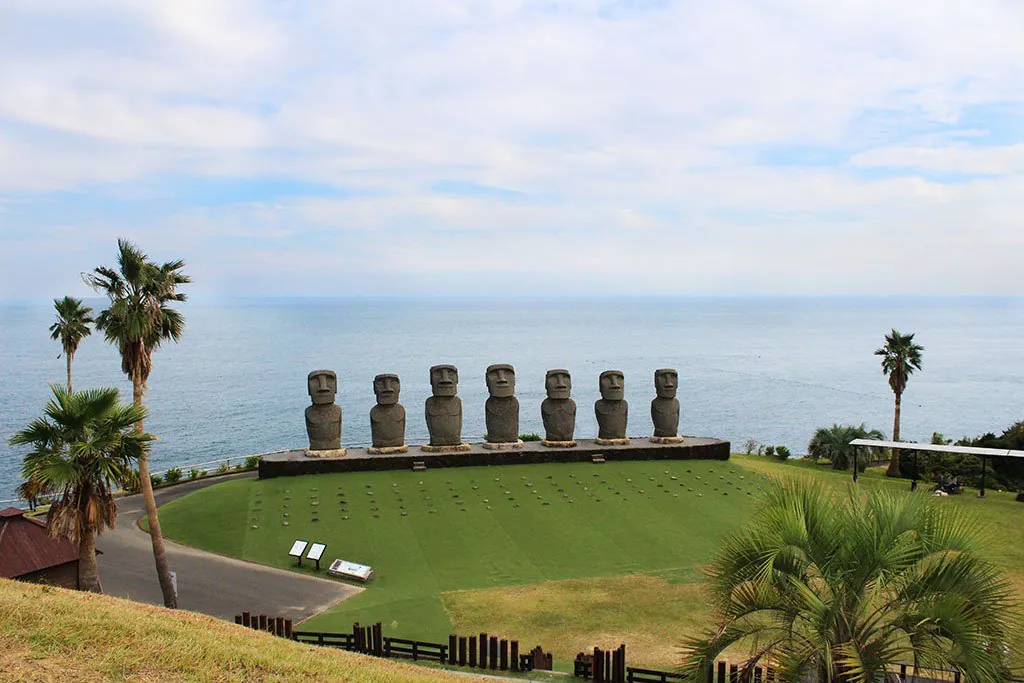
Tongariki is where you will get your once in a lifetime photo that will remove any doubts about the time and expense it took to get here.
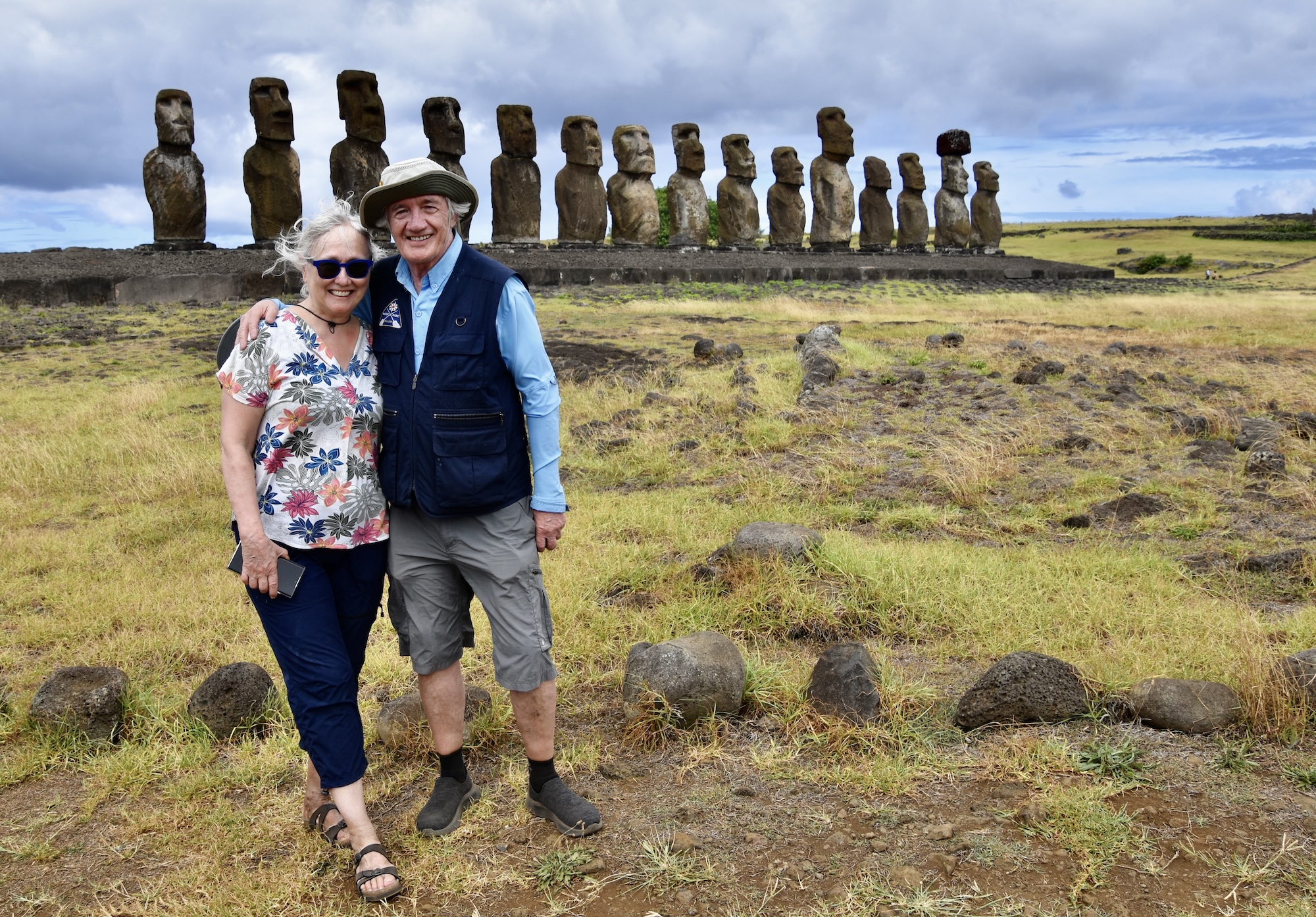
There is also a great view from here looking back at Rano Raraku and you can appreciate what a chunk of the volcano the moai creators removed.
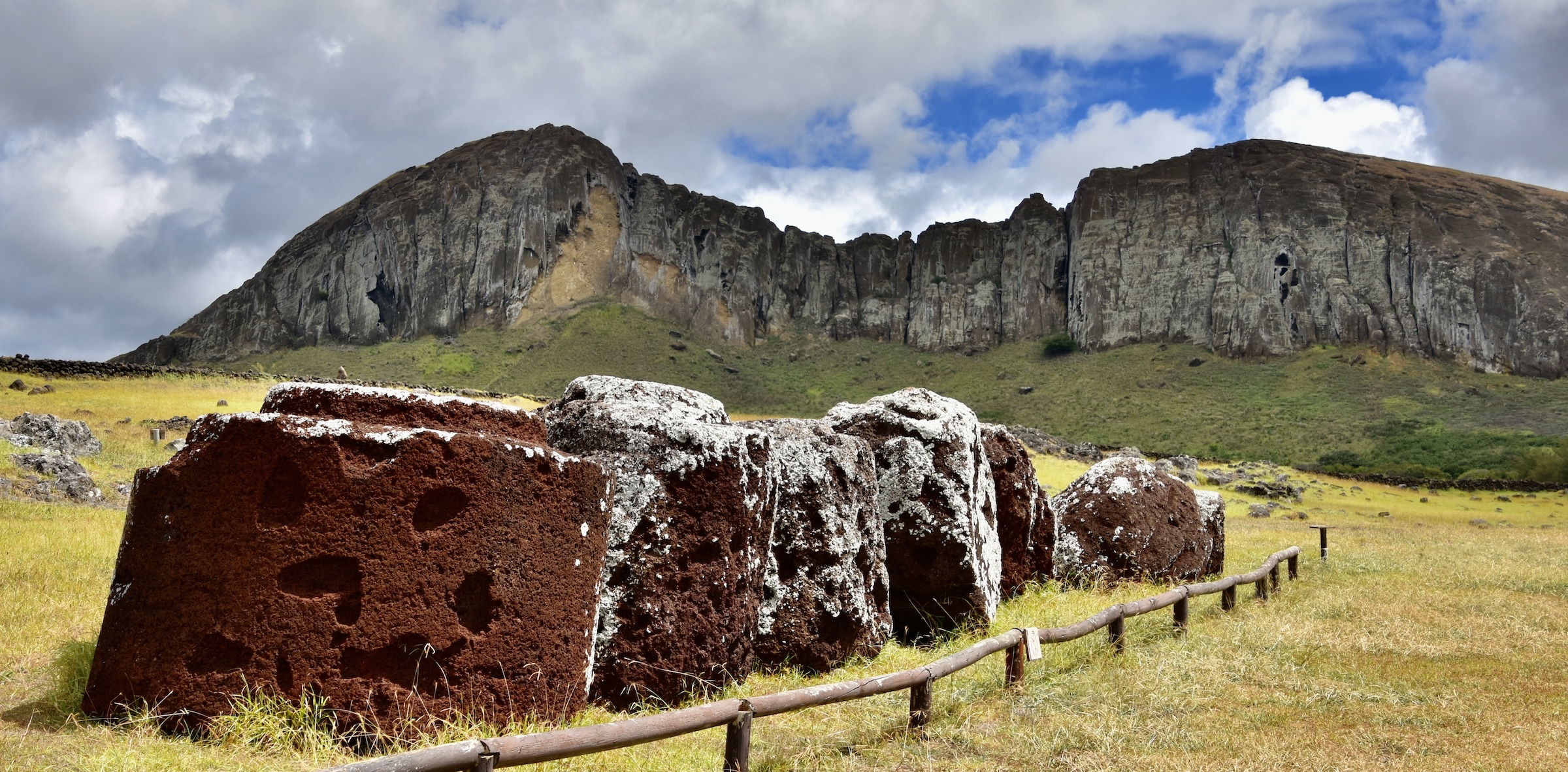
After taking photos from the side –
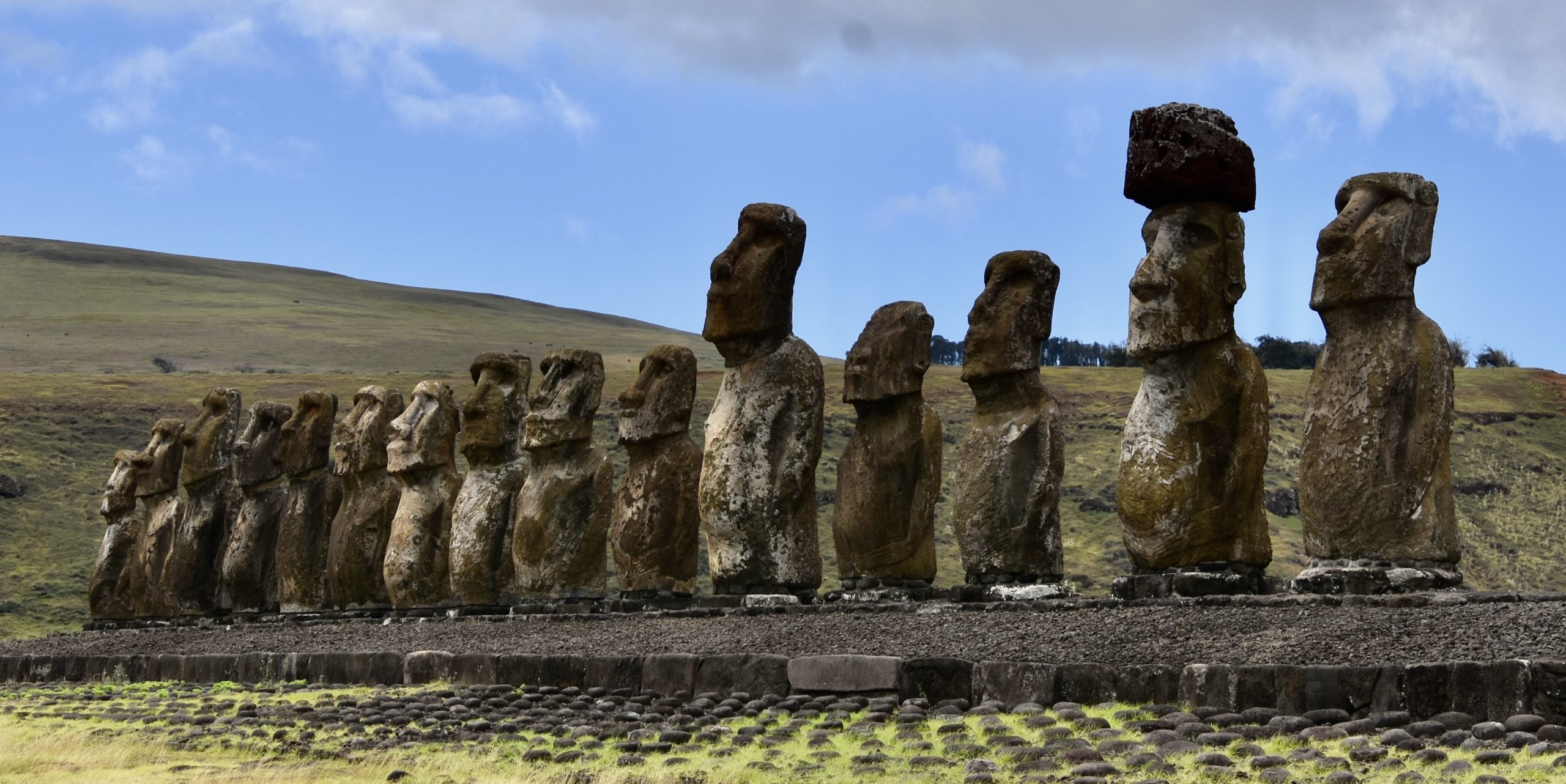
And the back.
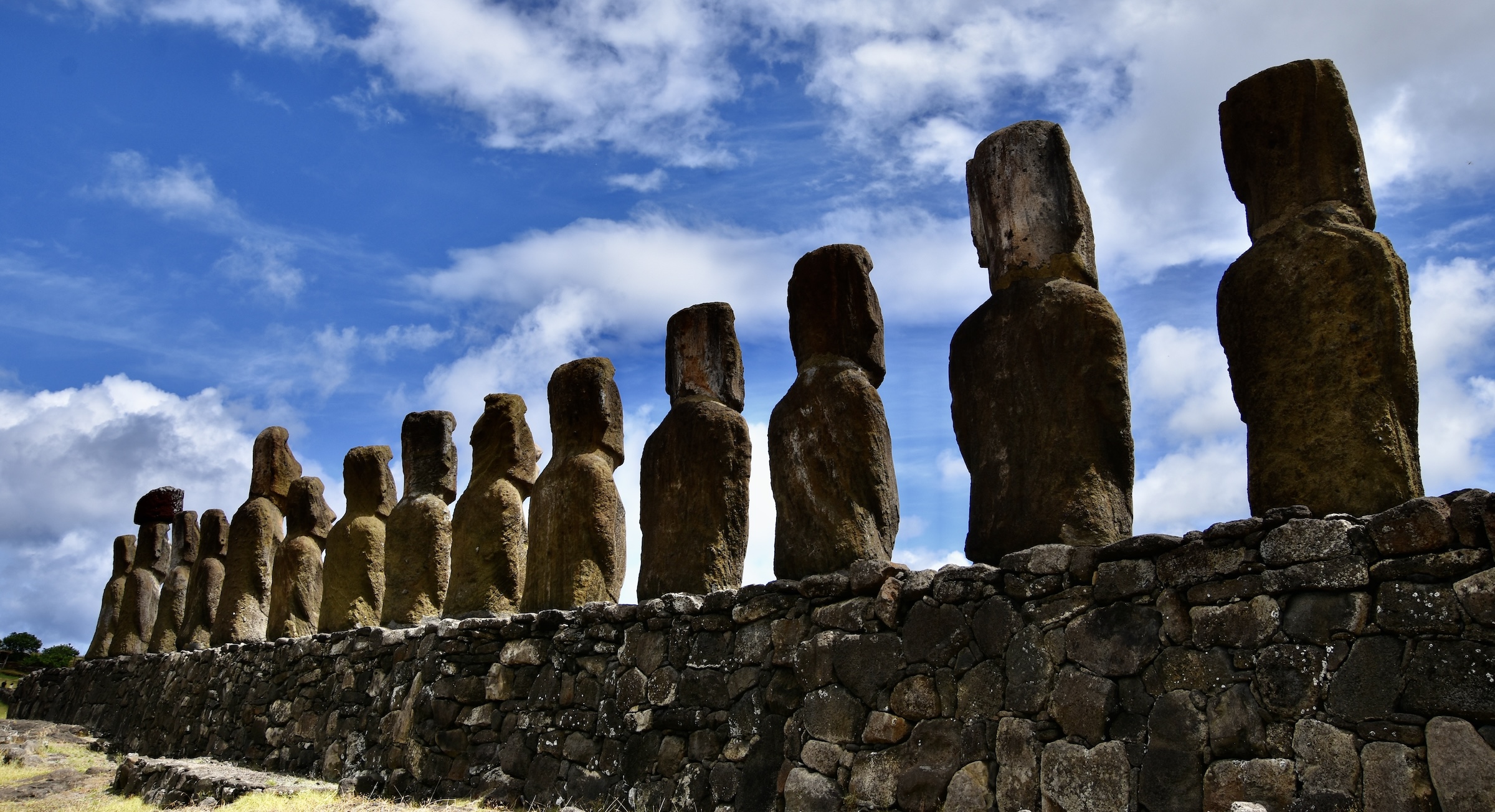
It’s time to head to our final Rapa Nui site which just happens to be where it all began.
Playa Anakena and the First of the Resurrected Moais
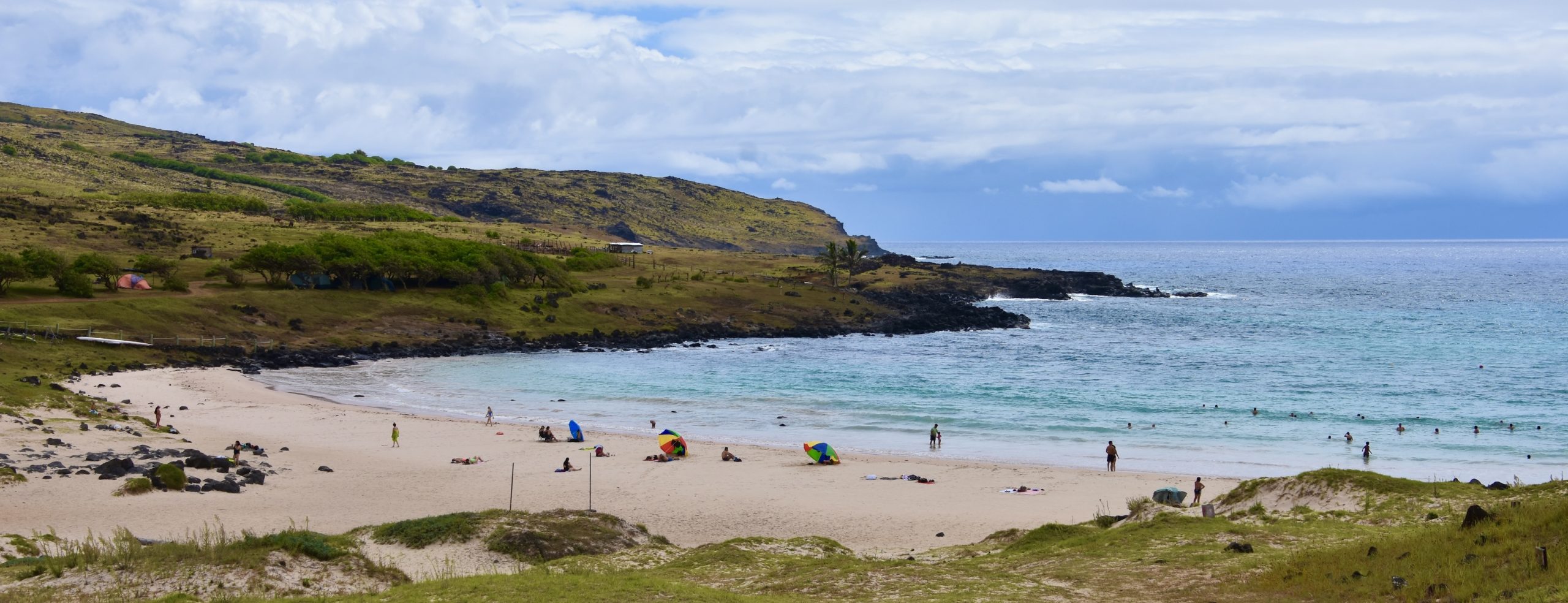
This is Playa Anakena, aka King’s Landing where Hotu Matu’a is said to have been the first human being to ever set foot on Rapa Nui. Today it’s a pleasant park with a couple of restaurants, one of the few beaches on the island and of course, some more moais.
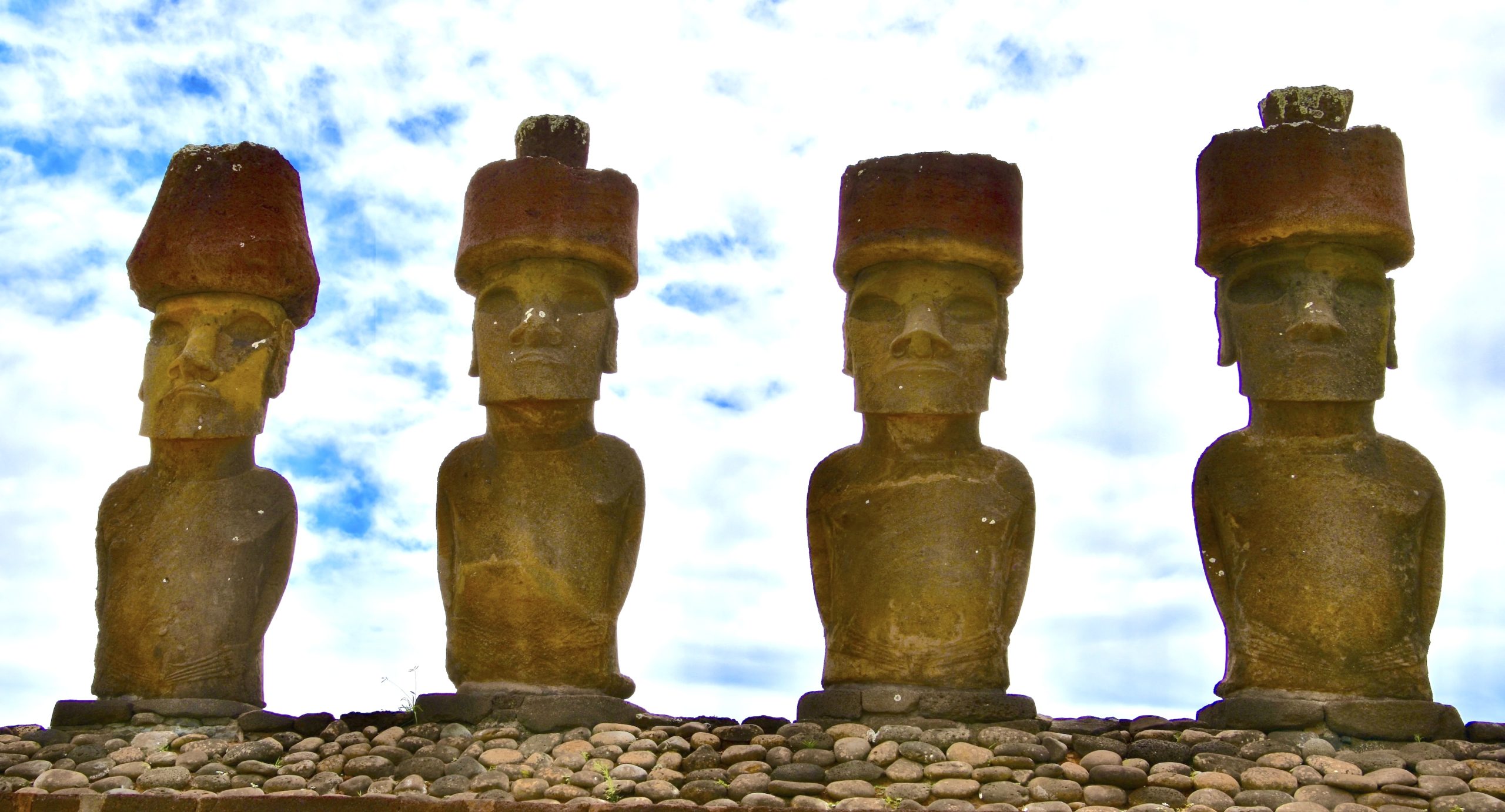
The very last moai we visit on Rapa Nui was, somewhat ironically, the first one ever resurrected by William Mulloy.
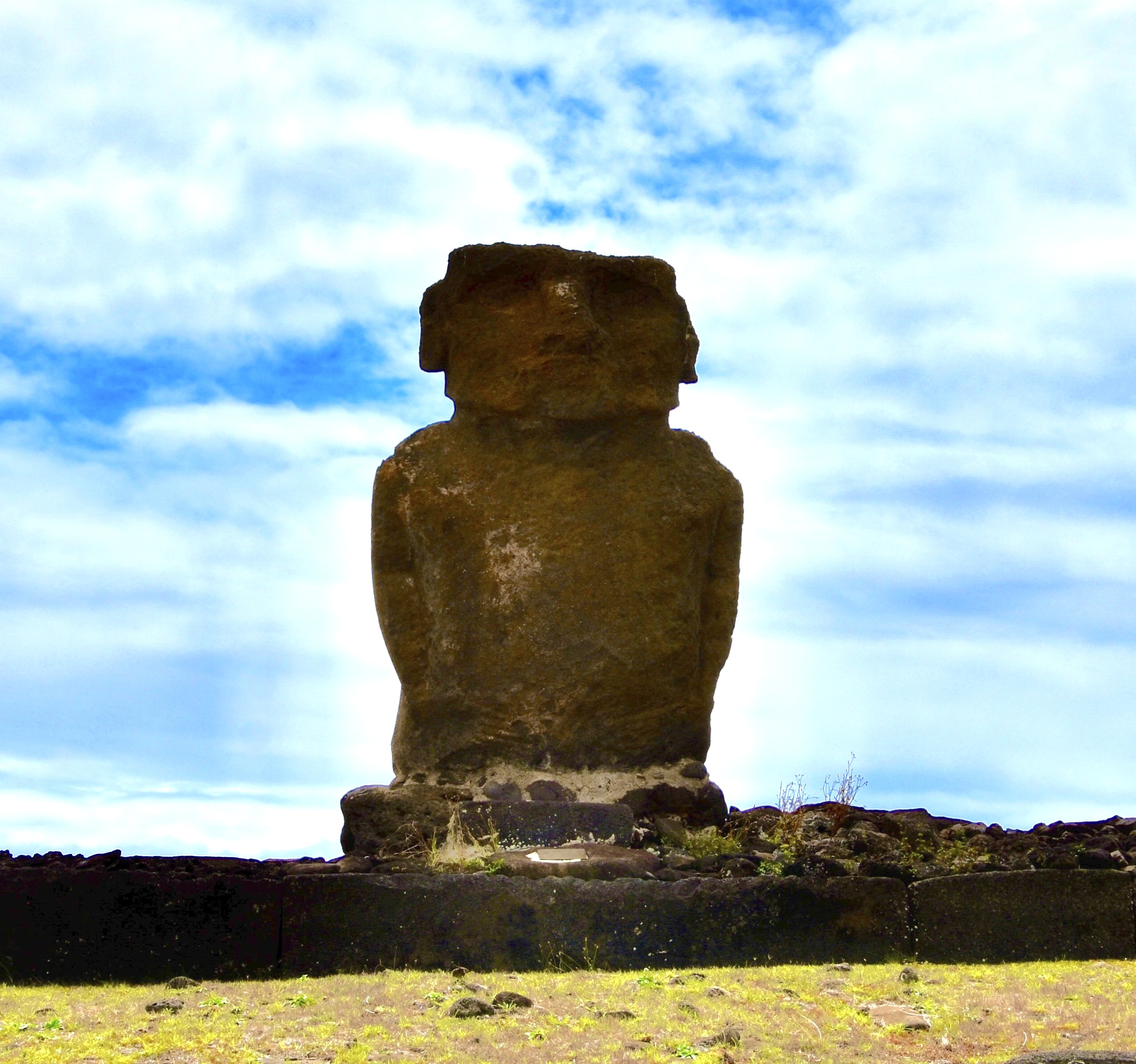
Well we’ve had one hell of a time visiting the various must see sites on Rapa Nui, but the fun’s not over yet. Tonight we are going native.
Te Ra’ai
For the grand finale of this Chilean trip of so many highlights, Chris took us to an evening of interactive Rapa Nui dancing and singing. By interactive I mean that we were part of the action.
This is Chris getting prepped. He definitely does have a resemblance to Gene Simmons.

And us.
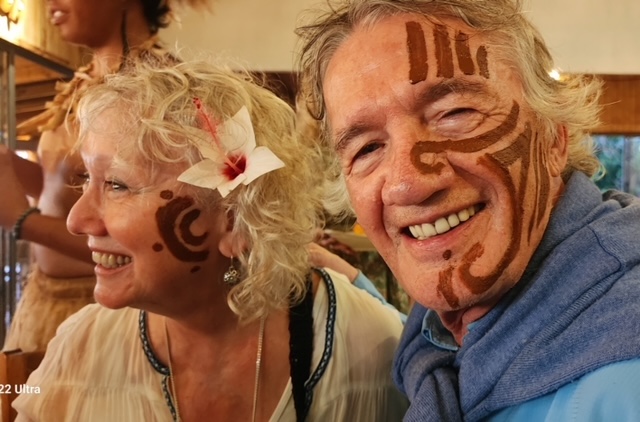
And Mikle.
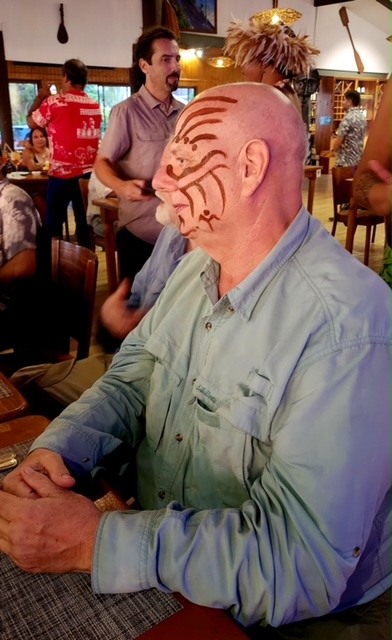
And Dottie, never far from a pisco sour.
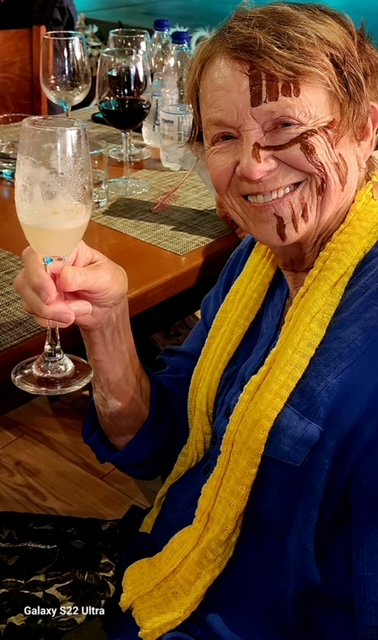
Collectively we looked like this.
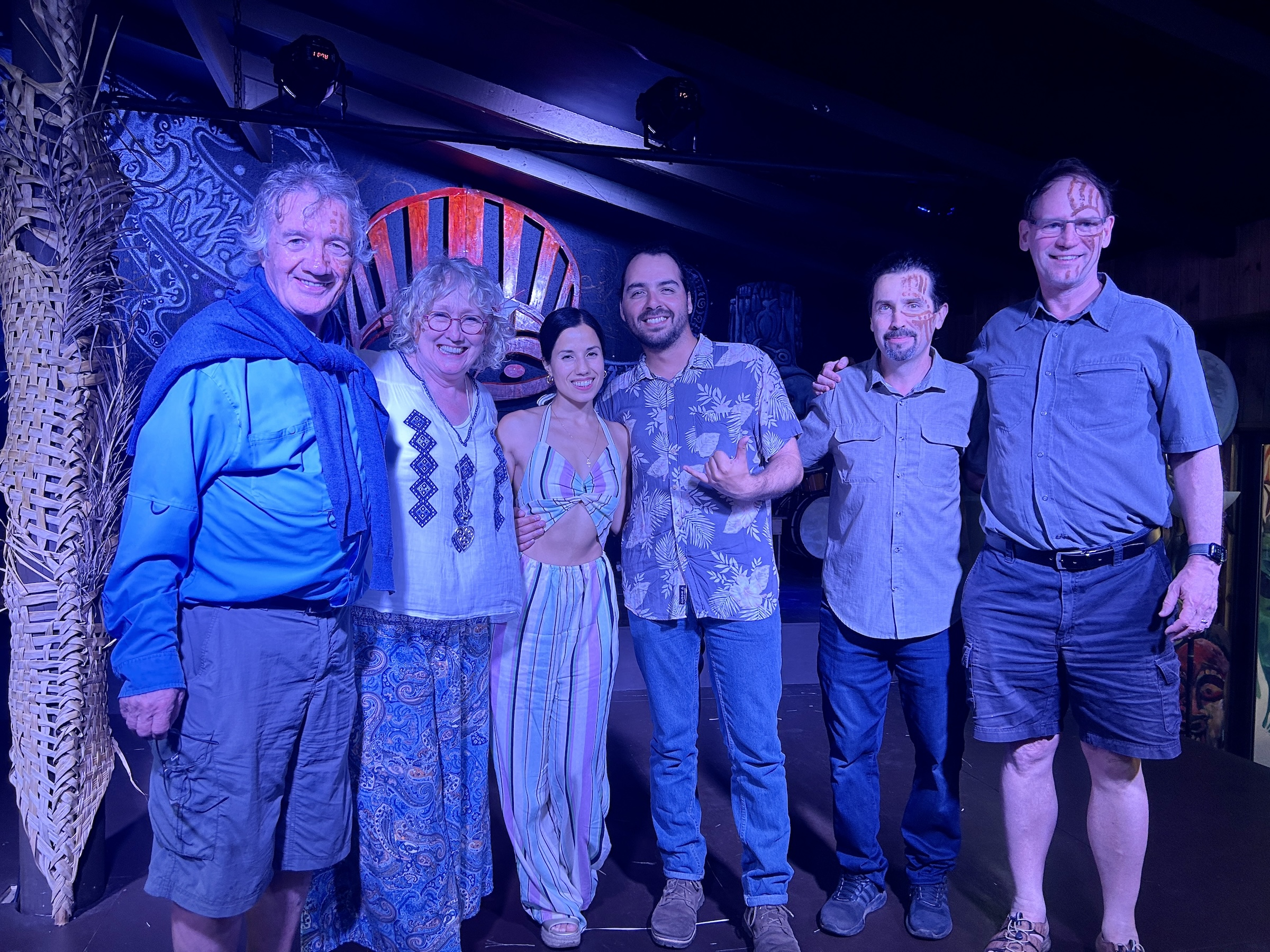
And among the troupe, like this.
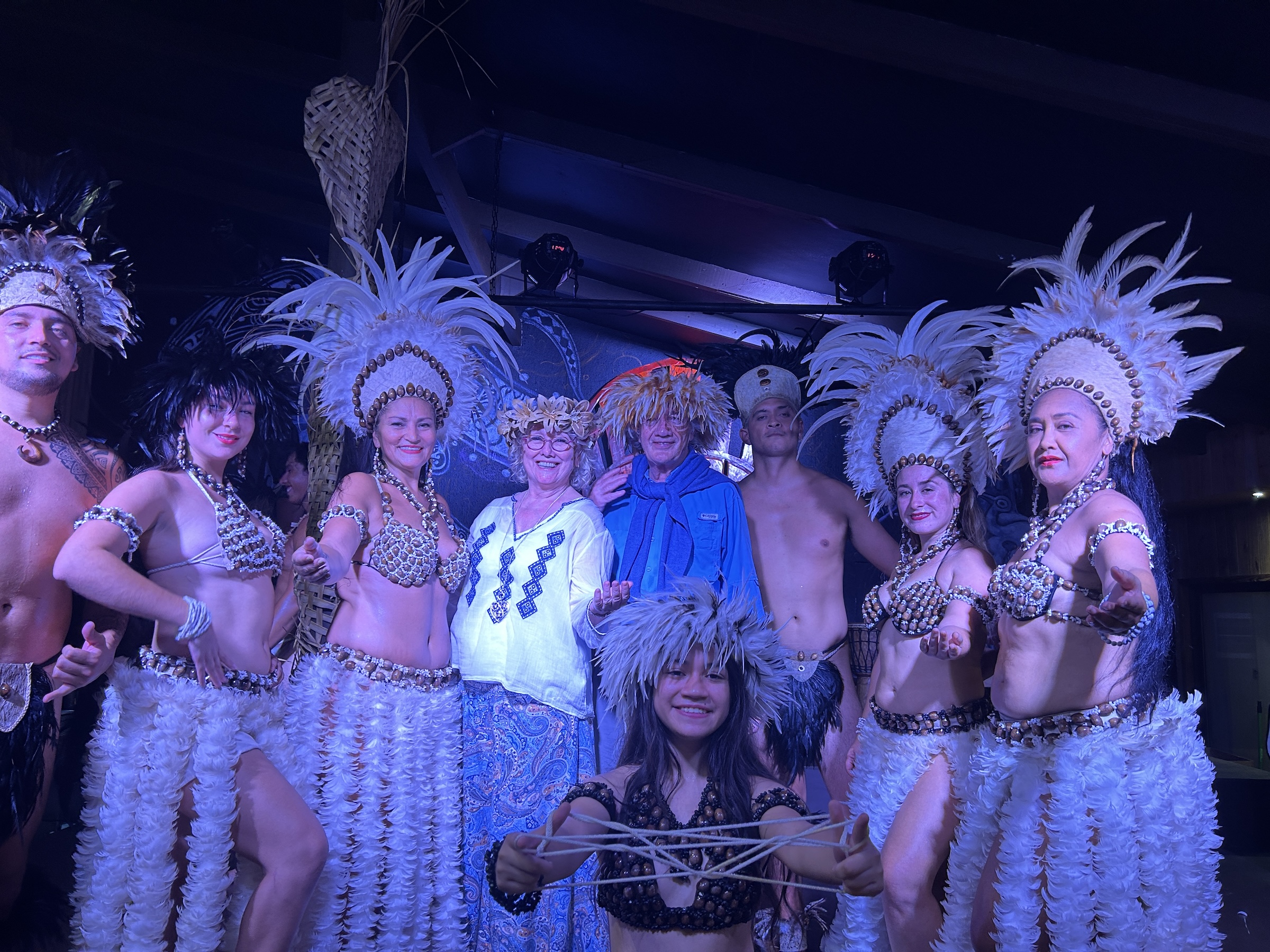
It was a wild and wonderful way to end one of the best AA trips we have ever been on.
The next morning we said our goodbye to Rapa Nui and to Chris. I hope we travel together again friend.
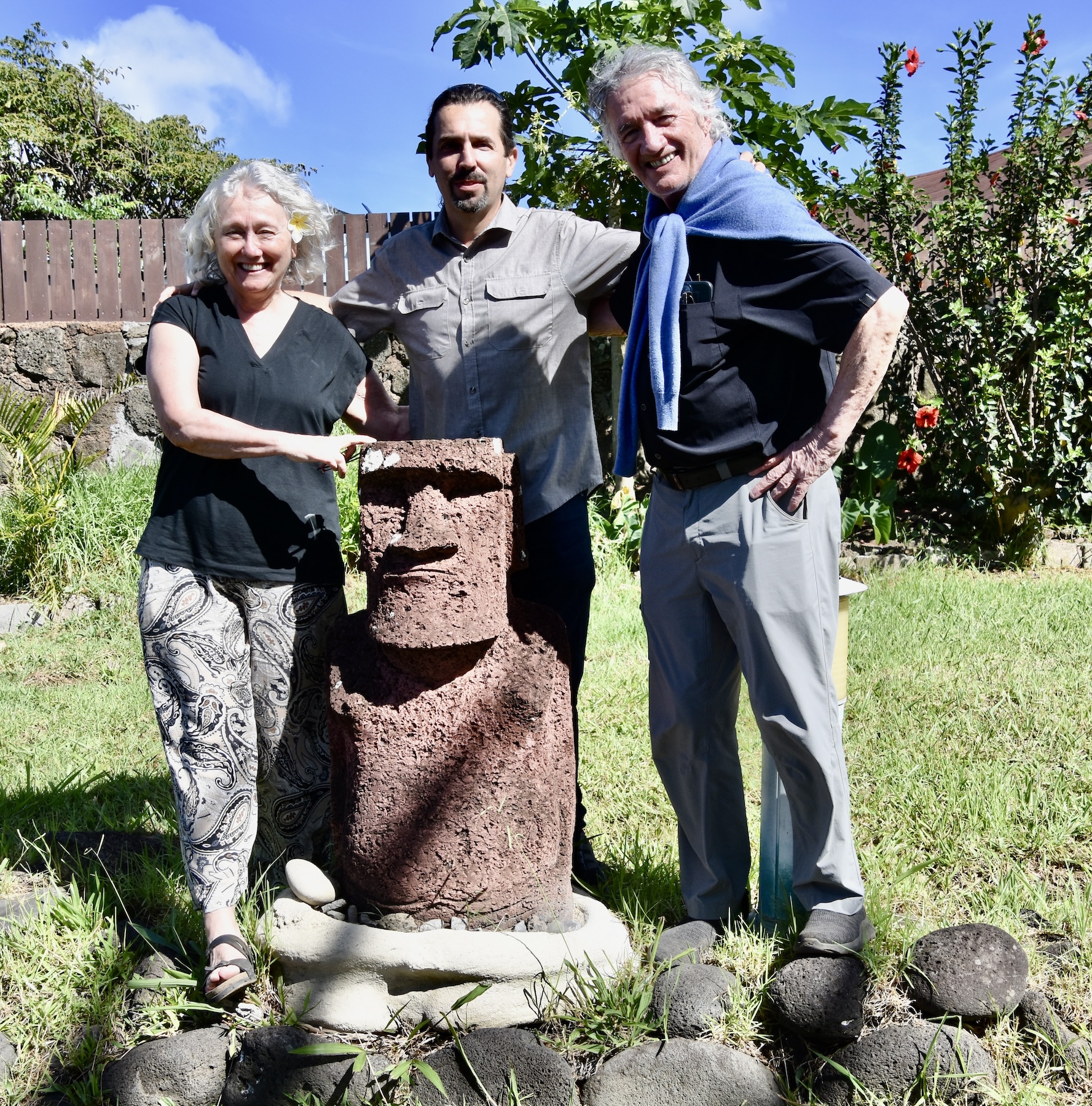
And for the grand finale, this wonderful video by George Sheen that either make you jealous or rush to book the next AA trip to Chile. I highly recommend the latter.


